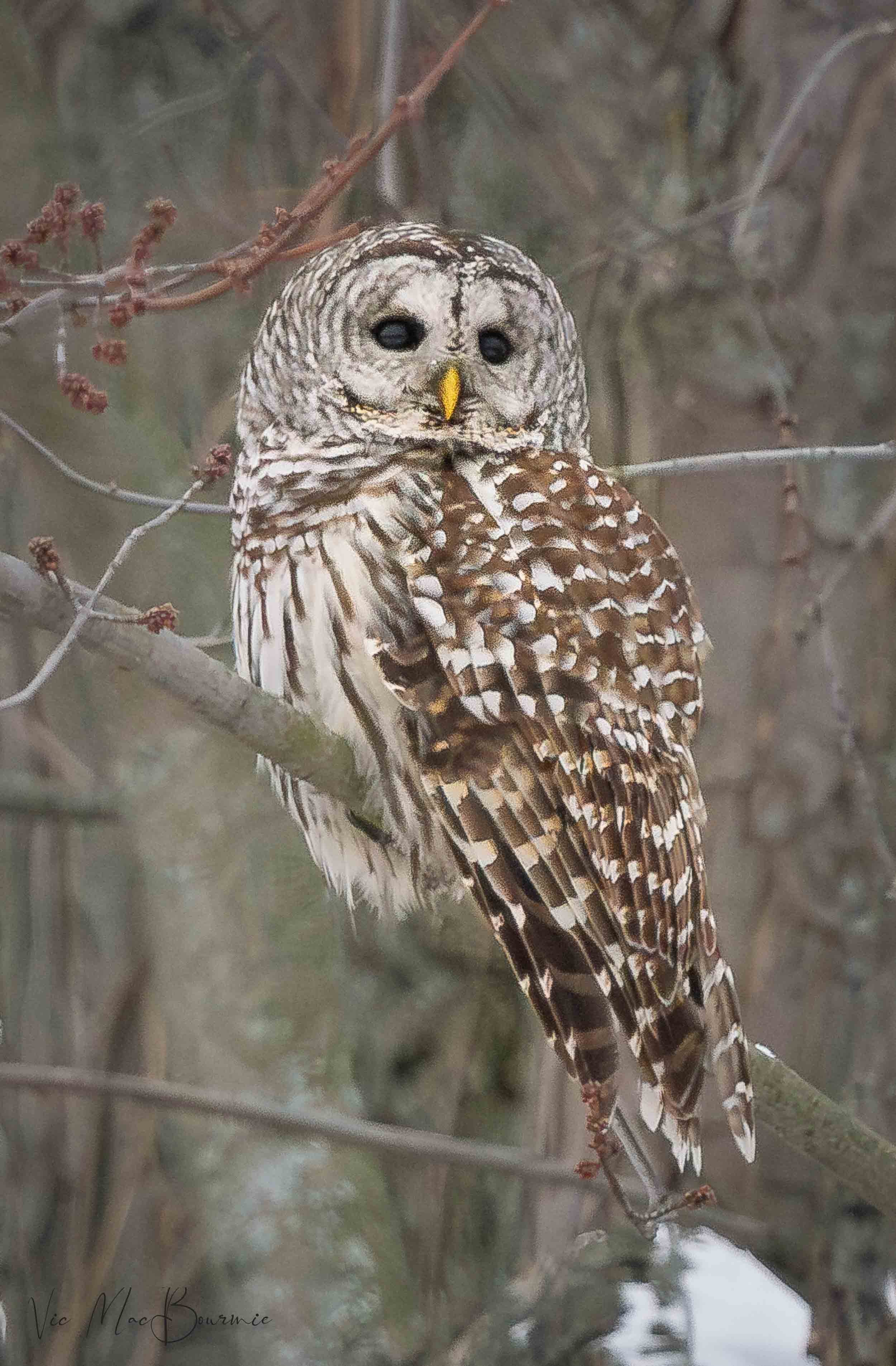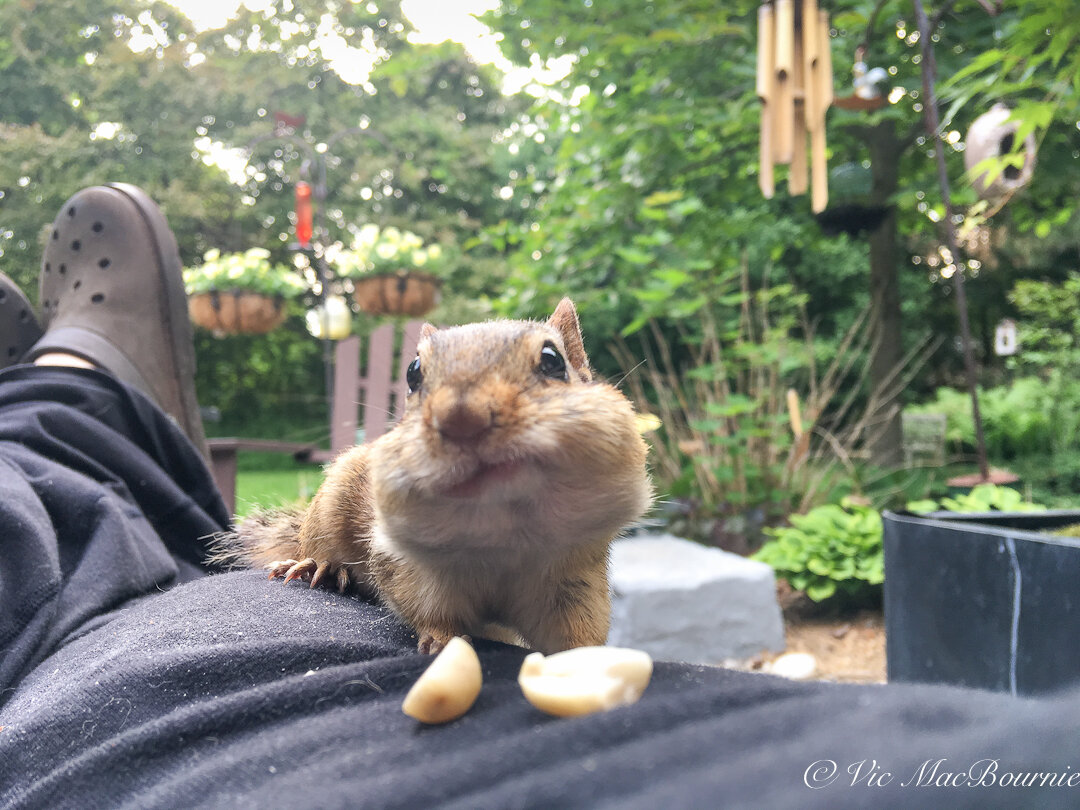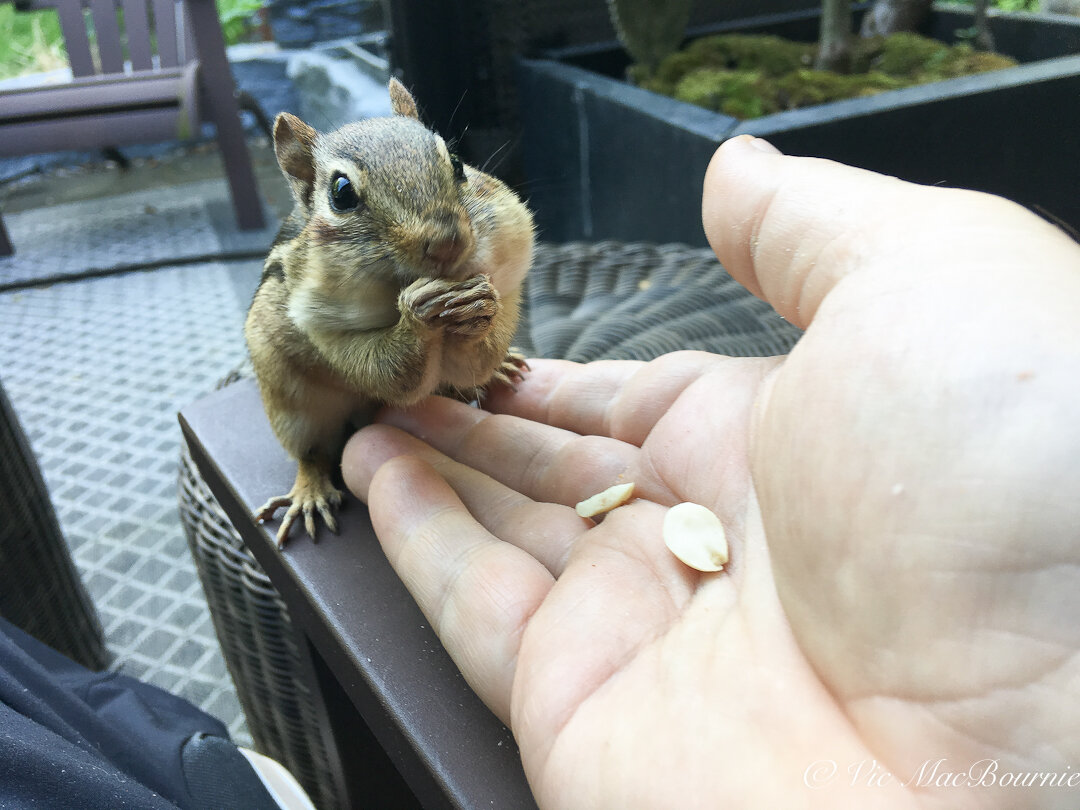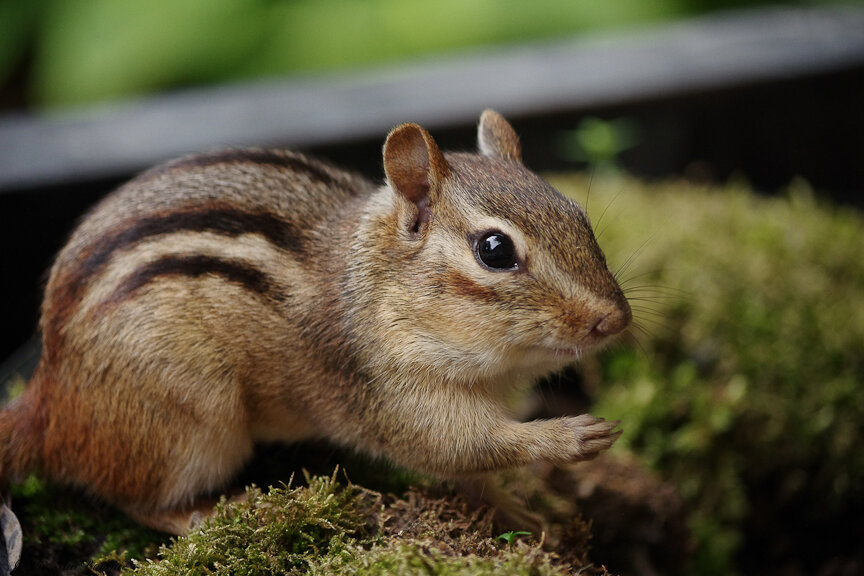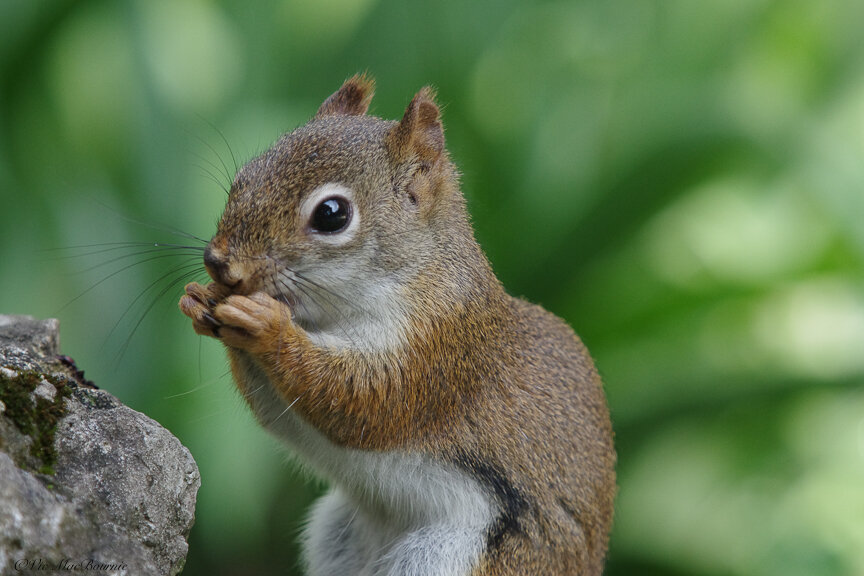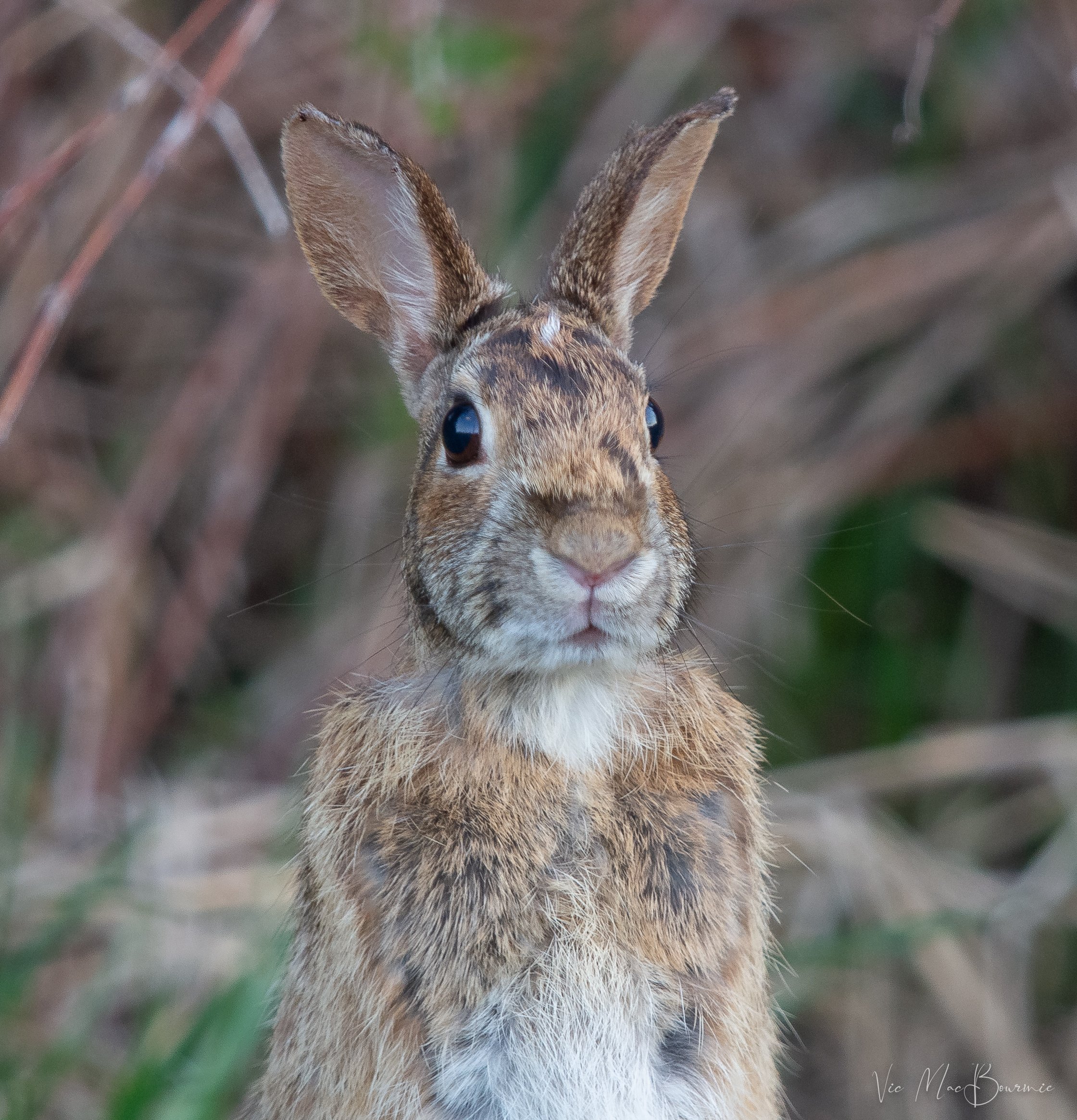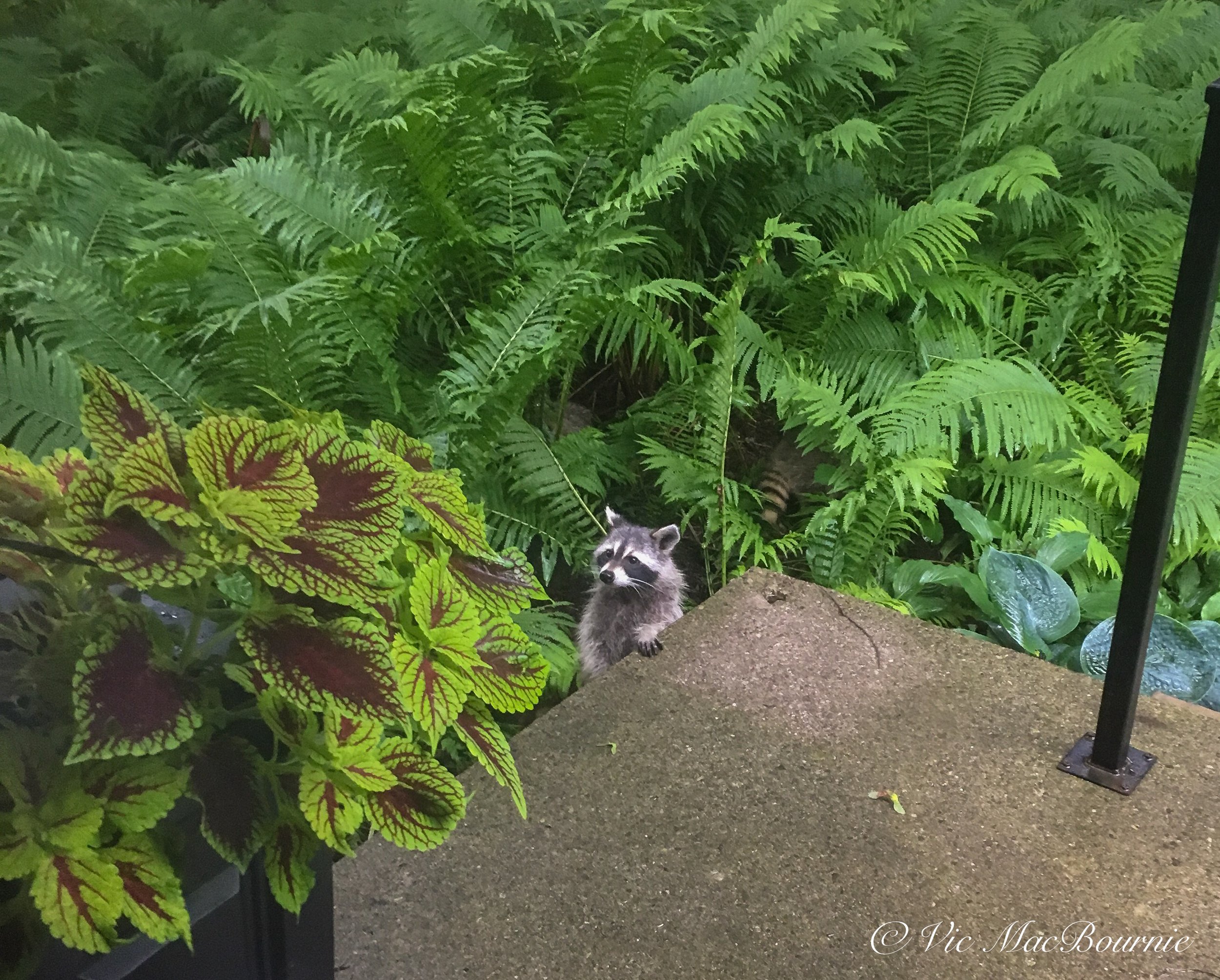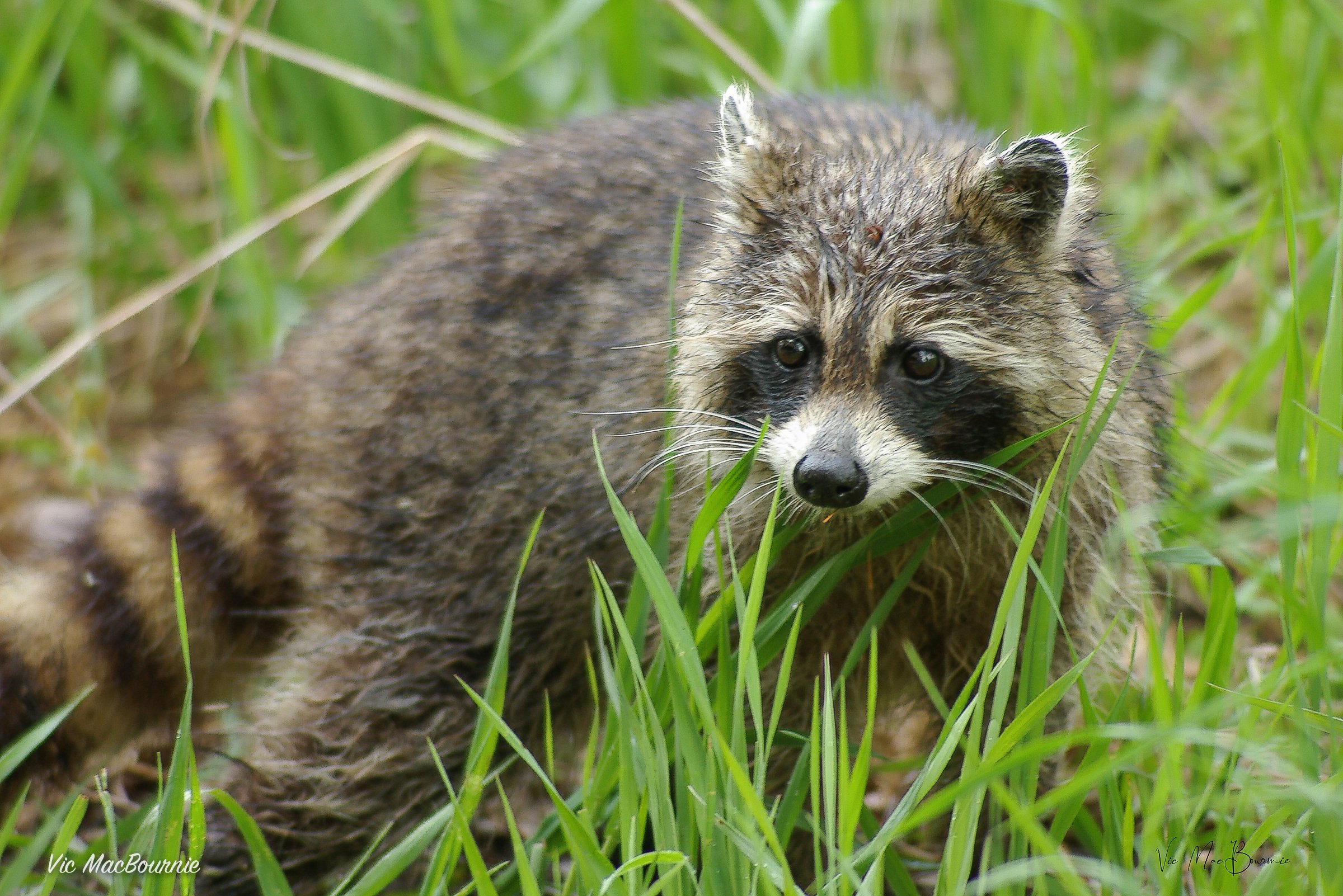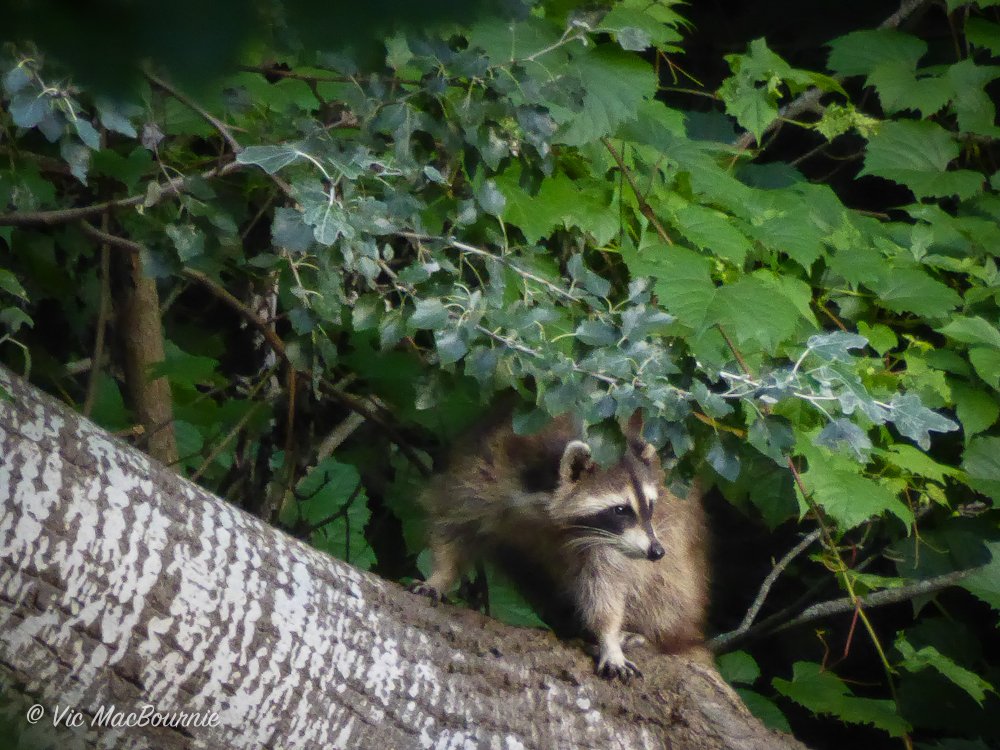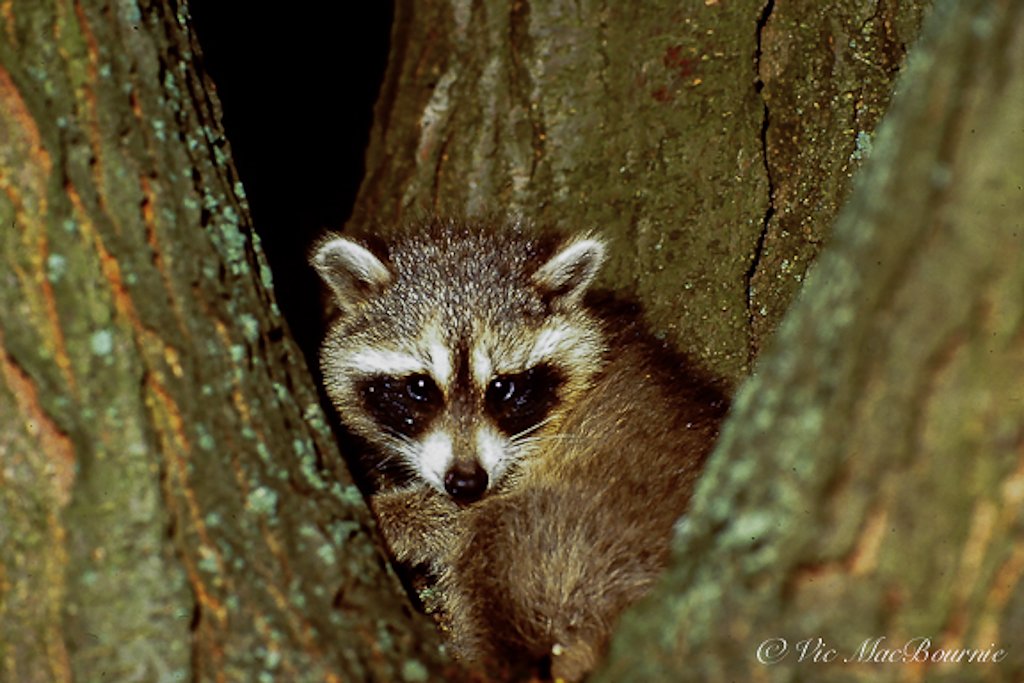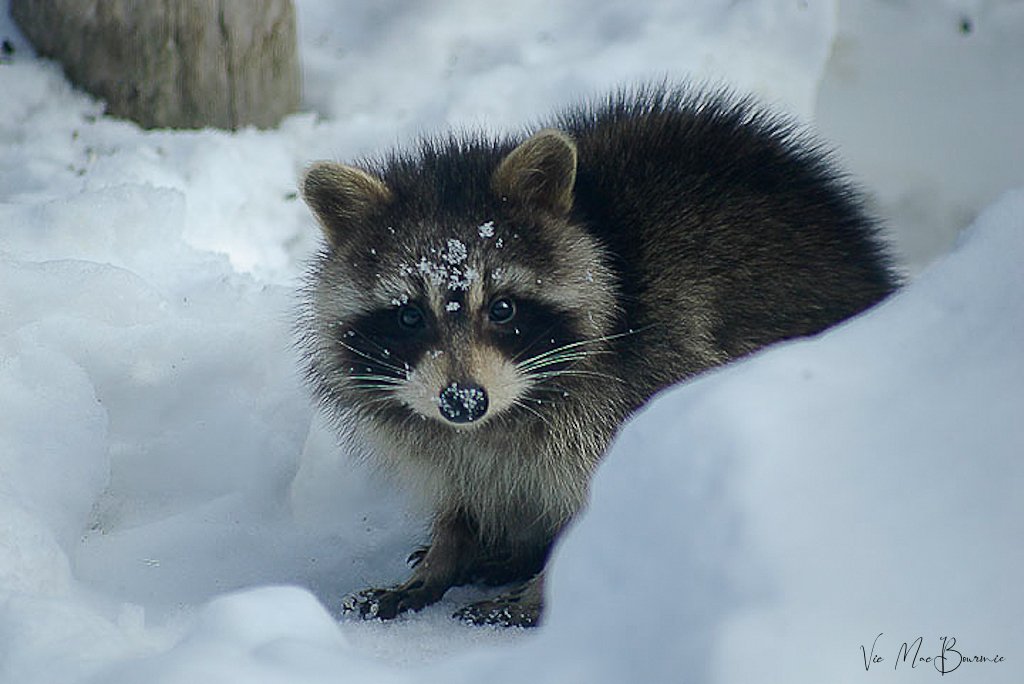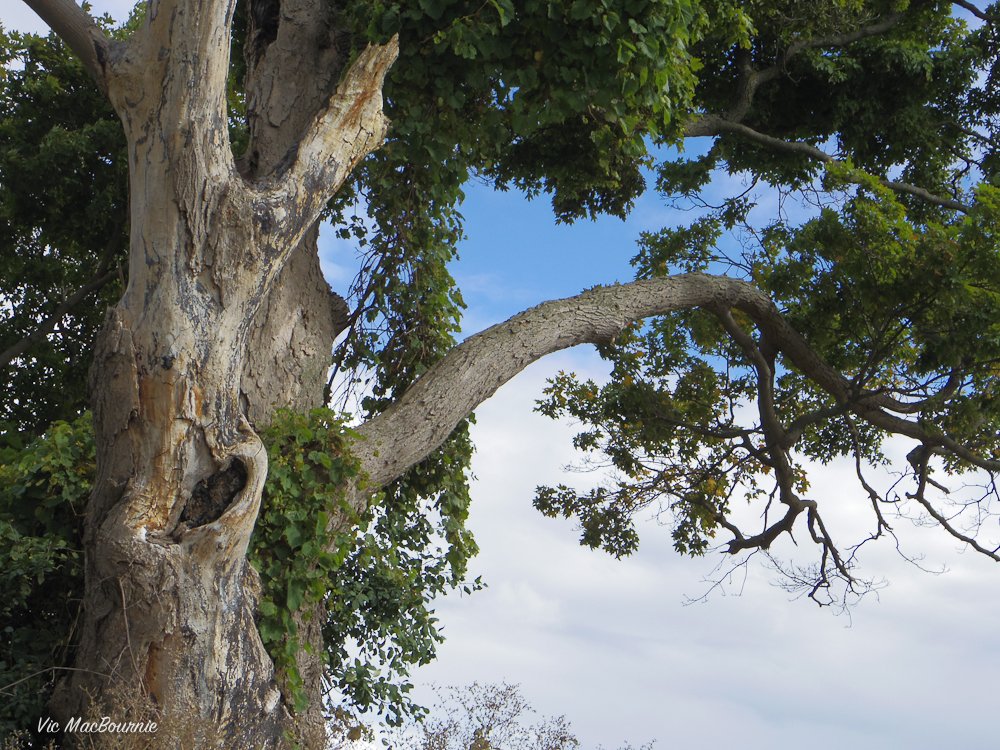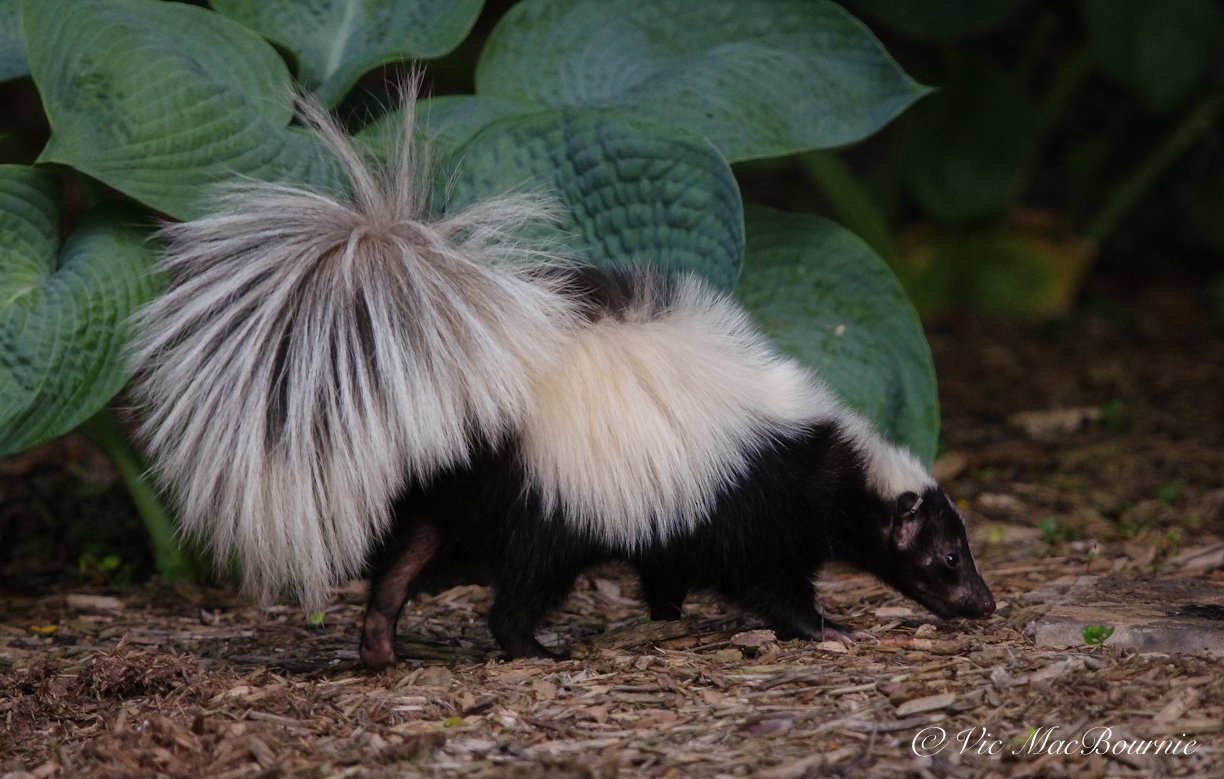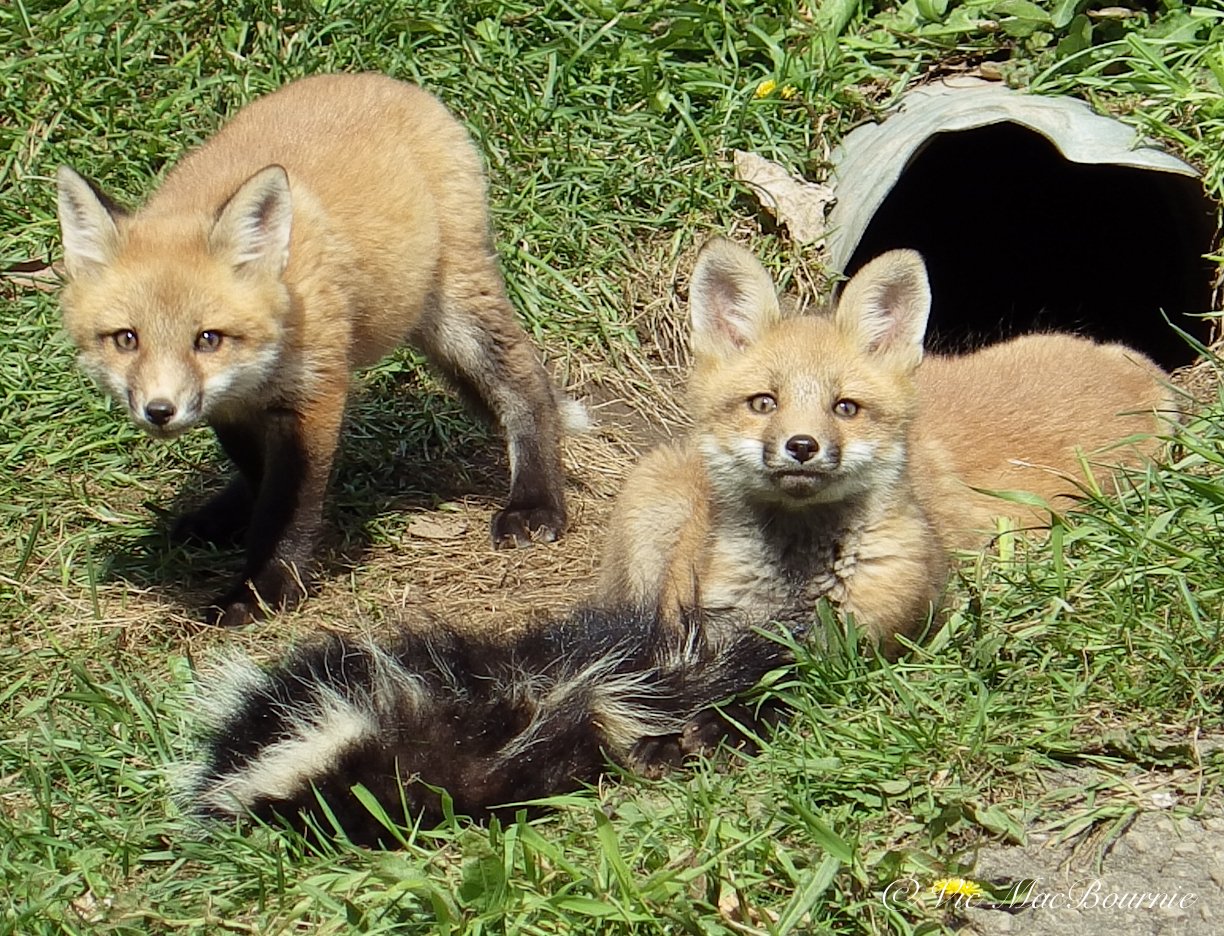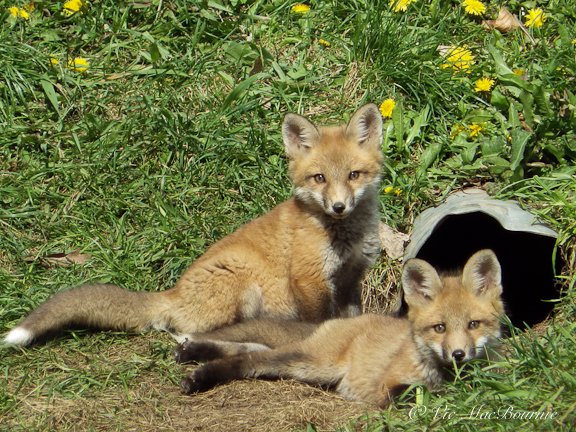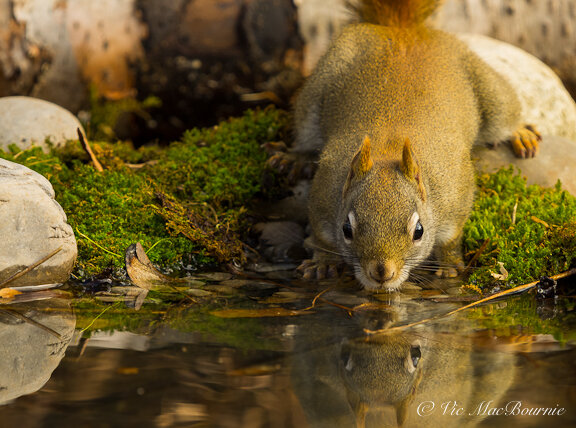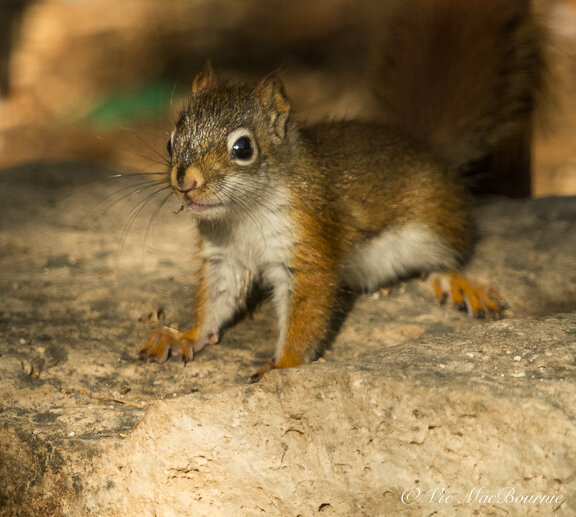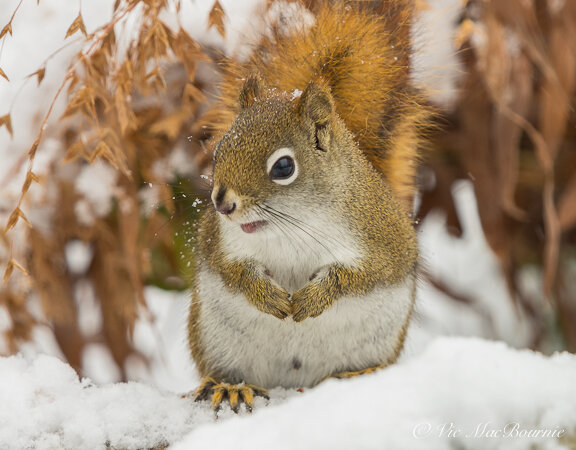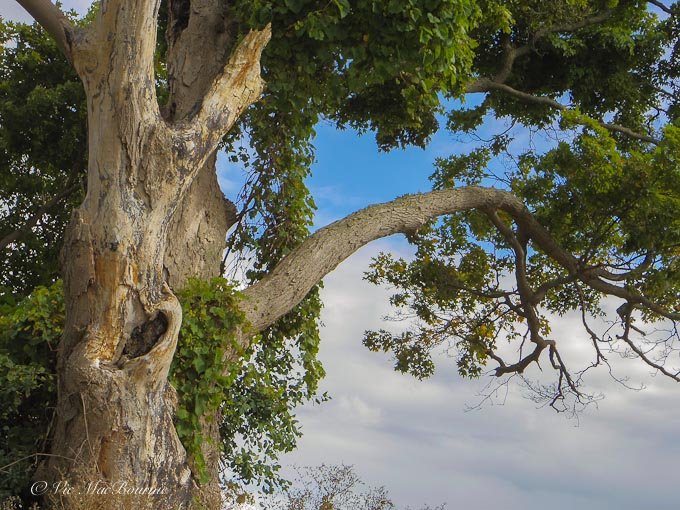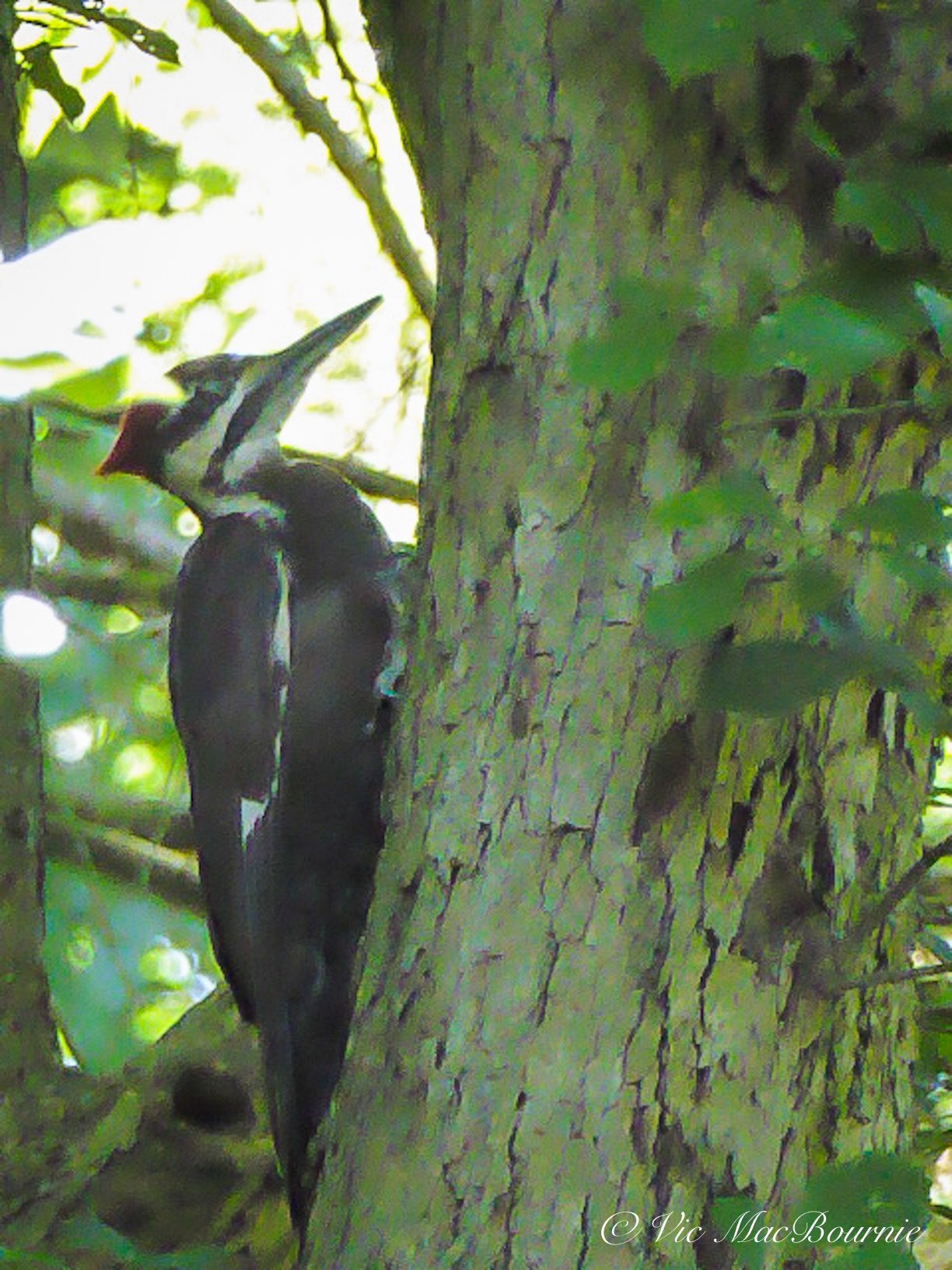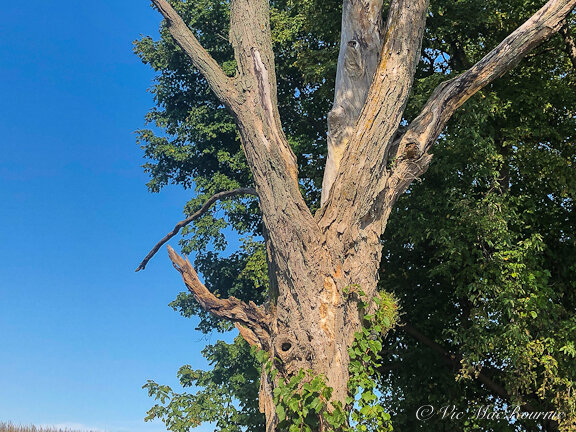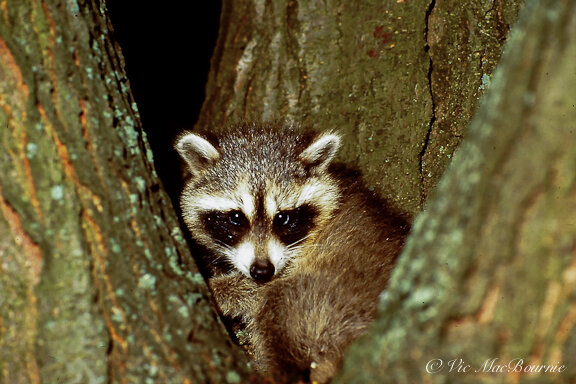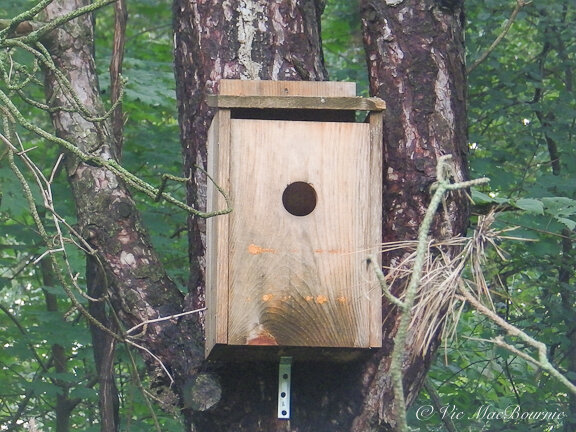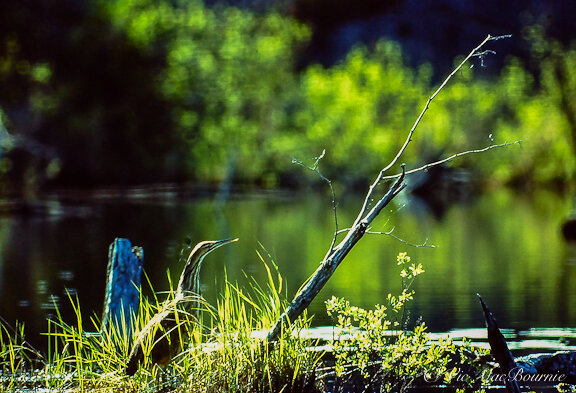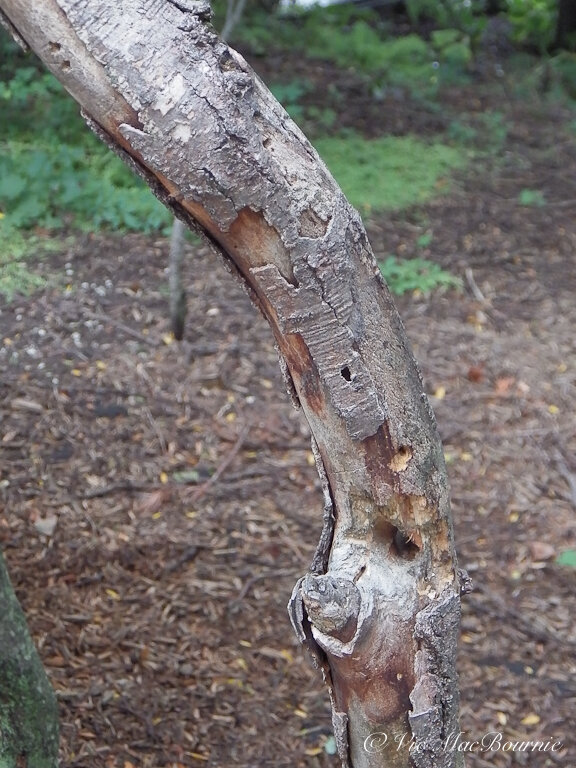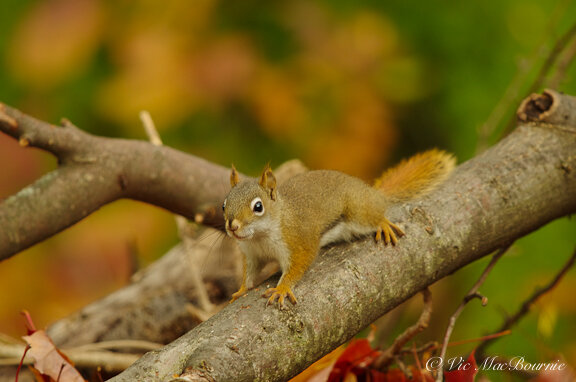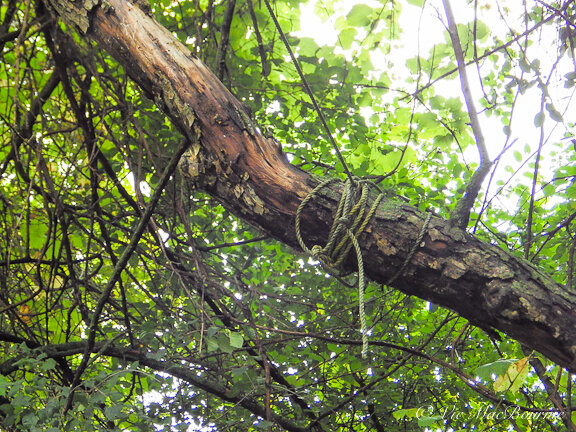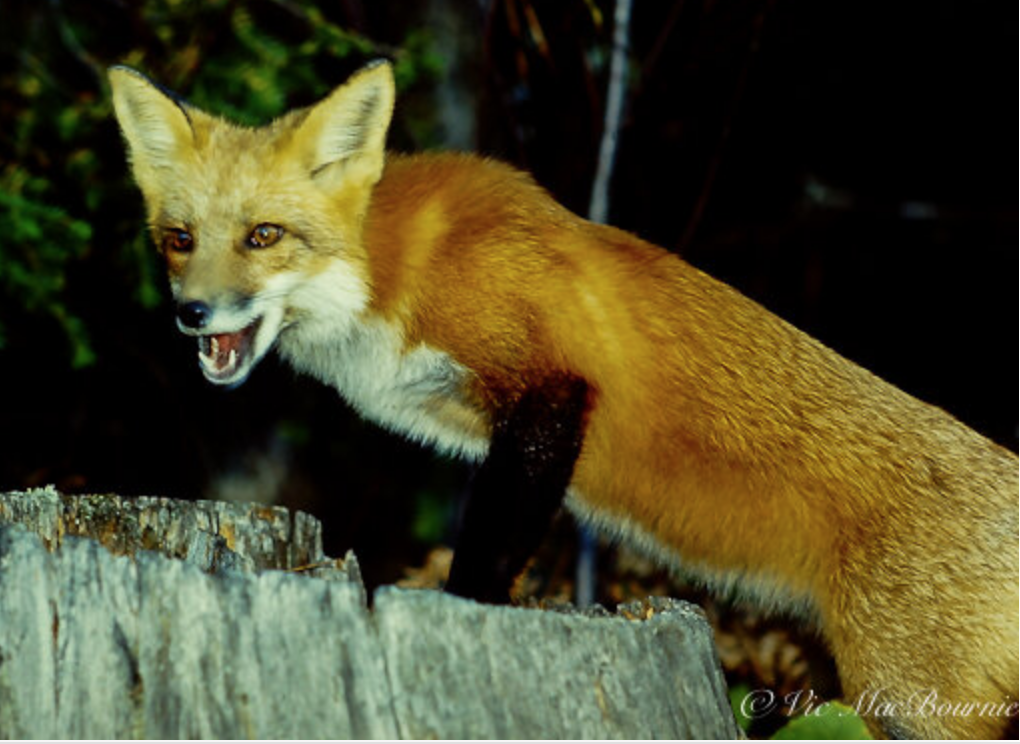A winter of wildlife in the woodland
Winter can be the perfect time to watch for wildlife in our gardens. Besides the regular cast of characters, watch for more elusive wildlife that may visit your garden in winter, when they are much easier to spot in the barren, snow-covered landscape.
Owls, coyotes and turkeys, it’s been quite the winter
Winter is always a difficult time for gardeners.
It’s often too cold or dreary to be outside, and, although there are wintery days that our gardens are covered in snow and take on an almost fairy-tale look, most days are filled with imagining what could be once spring arrives.
But winter can be a wonderful time for wildlife. The trees are bare, the landscape is barren for the most part and we have better views of the birds and mammals that visit the garden.
Birds are obviously the prime winter visitors to our gardens, but if you are lucky enough to live in an area where wildlife is abundant, you may have attracted new visitors to your woodland or natural garden.
In our garden, a reliable source of water in the form of a heated bird bath, attracted a variety of birds and squirrels all winter. Our bird feeder brought in many of our familiar winter visitors – cardinals, blue jays, nuthatches, chickadees, Tufted Titmouse, wrens and a variety of woodpeckers.
For a full gallery of images, please click here.
The regular cast of characters from this Tufted Titmouse to cardinals and woodpeckers are regulars at the bird feeders. Be sure to check out my Winter of wildlife photo gallery in the link at the end of this post.
The bird feeders also brought in deer, especially as the snow covered more and more of the ground and made finding food more difficult. Our trail camera caught skunks, racoons, rabbits and an opossum also feeding below the bird feeding station.
A fox visits from time to time, no doubt cleaning up the mice that feed at the base of the bird feeding station.
For the most part, the garden hosted a familiar group of birds and mammals similar to past years.
With one big exception.
This winter was the year of the wild turkeys in our garden.
Last year, it was the winter of the screech owl. This year the owl did not return but was replaced by much larger avian visitors.
They first appeared in late fall under the bird feeders and decided that the conditions in our garden were enough to their liking that they pretty much stayed all winter.
This is not the first time wild turkeys have visited our yard, but it is the only time they have stayed for a prolonged period of time.
New this year is our resident wild turkeys who have decided that the woodland garden is a good place to spend the winter. Be sure to check out my Winter of wildlife photo gallery in the link at the end of this post.
Of course, the regular supply of food from the bird feeders played an important role, but the supply of natural seed from our Northern Sea Oat grasses also became a favourite food source for our two male wild turkeys. (It started out as three male turkeys but early on the less dominant turkey of the group disappeared and has never been seen since.)
It’s been a wonderful winter watching our turkeys grow from fine young males into more mature Toms. A day rarely goes by that they don’t greet me when I go out to fill up the feeders. We have long conversations on almost a daily basis about whatever is on our minds.
They’ve come to trust me but are quick to move away if I get too close to them on my way to the feeders.
They are relatively safe here. Our dog, Holly, passed away in the fall and although there are dogs behind us, a hill across the back of our property provides some cover and a fence keeps the dogs at bay even if they spot the wild turkeys, rabbits, etc.
I expect the time will come soon when the Toms wander off into the woods to find mates. I’m sure they will bring their families around at some point in the summer. Last year, I counted 17 turkeys (mostly babies) in the back yard at one time.
I have spend the winter capturing images of these birds, never knowing when they will move back into the shelter of the larger woodlands.
Give a hoot about owls
I was able to capture an image of this lovely Barred owl in the woodlands near our home. It’s important not to use any poisons in your garden to control mice, the main prey of these lovely birds.
Be sure to check out my Winter of wildlife photo gallery in the link at the end of this post.
Getting out to capture a greater variety of wildlife
While our garden provides endless joy and photographic opportunities even in winter, I like to get out and experience wildlife in the nearby woodland or even farther afield.
As a wannabe wildlife photographer, getting out of the garden affords me the opportunity to photograph wildlife that is not present in our garden.
This year, I was intent on capturing images of a few more elusive birds and mammals that are not regular visitors to our yard.
Struck out on the Snowy Owl but got another instead
First on my list was the snowy owl, which have yet to photograph, despite driving all over Ontario in search of these migratory overwintering birds. There is still hope, but my chances are fading fast.
That’s not to say my attempts were in vain. One evening, while I was out looking for Snowys, I came across a lovely Barred owl in the woodland near my home and captured successful images of this beautiful owl.
After weeks of trying to capture a good image of a coyote, I was fortunate enough to meet up with this beautiful coyote in a nearby woodlot. Be sure to go to the link below to read about the memorable ten seconds of time we spent together face-to-face on a woodland path. Be sure to check out my Winter of wildlife photo gallery in the link at the end of this post.
It’s an important lesson for photographers and nature lovers to just get out and experience the world around us because you never know what you are going to stumble upon.
In search of coyote images
Second on my list of winter wildlife images I hoped to capture this winter was a coyote. Weeks of searching for them in freezing conditions paid off with a wonderful, up-close encounter with a lovely coyote and resulting images. For the complete story of my coyote encounter click here.
Sandhill Cranes: A morning of great promise
A few weeks later, after many failed attempts to photograph coyotes and snowy owls, I decided it was time to visit the winter migratory home of Sandhill Cranes that gather by the hundreds in a lakeside town about 1.5 hours from where I live.
Going to an area where you know there is a very good chance of capturing wildlife images is always a good idea, especially after weeks of failure out in the field.
A morning with the Sandhill Cranes resulted in hundreds of usable images, but only a handful of good images that I can be proud to show here and on other social media sites.
It’s been a long winter for many of our backyard wildlife friends. Our chippy popped up out of the deep snow to enjoy a little of the warmer weather and was even seen wandering on top of the snow looking for a late-winter food food source.
Surviving a brutal winter
As our brutal winter loosens its grip on our gardens and natural areas, I have noticed more wildlife leaving the comfort of their dens in search of food. Last week, while searching for snowy owls, I came across a young raccoon that was out walking about on top of three feet of snow no doubt looking for food.
Earlier this week, I watched one of our many chipmunks leave the safety of its underground burrow to enjoy a little sun and go out in search of food.
It’s been a difficult winter for wildlife. Heavy snowfall has its benefits for some wildlife that benefit from its cover and its insulation value. However, it creates serious hardship for many others that find obtaining food difficult when the snow cover is so deep.
The diminutive screech owl, for example, is apparently having difficulty capturing enough mice to survive the winter in this area. Wildlife rehabilitators, for example, are apparently reporting an increase in malnourished owls being brought to their facilities.
We can do our part to help wildlife in our gardens by providing the necessities of life – water, food and good, safe cover.
Consider using this winter as an inspiration to ensure the wildlife in our gardens not only survive in but prosper when winter returns next year and in the years to come.
I am sure that if you are kind to our wildlife, you will reap the rewards every day in your wildlife garden for years to come.
For a full gallery of images, please click here.
Coyote in the woodland: Capturing its essence
Days in the making, a fraction of a second in the taking. Capturing the elusive coyote in a winter woodland.
For two weeks I tramped through snow and ice in freezing conditions to capture an image of the elusive coyote. Then, like a ghost, it appeared. Seconds later it was gone.
When mere seconds make all the difference
About five seconds. That’s all this beautiful coyote gave me.
Then, it wandered off into the woods leaving me alone in a wintery woodland to contemplate what had just happened.
I’m sure many readers have experienced a similar encounter either with a coyote, fox or maybe just a favourite bird. They are often unforgettable moments – slivers of time that enable us to step into their world, if even for just a few fleeting seconds.
Having an unexpected wildlife encounter – while exciting and memorable –is quite different than going out with the prime purpose of capturing a successful image of an elusive animal.
This is the story of how I was able to capture, in a fleeting few seconds, a handful of images that I had been chasing for weeks.
Anyone who accepts the challenge of wildlife photography knows that it is often hours, even days, of boredom interspersed with just a few seconds of action. That certainly holds true with my recent coyote encounter.
Animals operate on their own schedules and, although we can sometimes predict their routines, we can never be sure of their specific movements on any given day.
For days I had been visiting an area in a nearby city where a group of coyotes were regularly seen travelling along a bike/walking path. They were quite habituated to seeing humans, so getting photographs of the elusive critters should have been easy. (I mean, everyone in the neighbourhood along the walking path told me they see the coyotes regularly.)
Unfortunately, days of walking the trails in freezing temperatures and sitting quietly into the evening waiting for them to appear proved fruitless.
Having an unexpected wildlife encounter – while exciting and memorable –is quite different than going out with the prime purpose of capturing a successful image of an elusive animal.
I spoke in a quiet, reassuring voice to catch her attention and convey that I meant no harm. She stared back as if to say, “I know you mean me no harm, but I will stay cautious and move on.”
Get more information about the urban coyote.
If you are interested in finding out more about the coyotes that live among us in urban environments, be sure to check out the book: Coyotes Among Us, Secrets of the City’s Top Predators.
Coyotes, foxes and other apex predators are on their own schedules and they rarely line up with ours. Seeing them in our yards at night, is not the same as getting useable images of them.
Wildlife, especially dominant predators, survive on instinct and that instinct warns them to stay away from human interaction as much as possible. As a result, they are not often out in the middle of the day. They thrive in the early morning light of dawn and the fading light of dusk when most humans are either in bed or at home having dinner or watching television.
Of course, these are the best times to pursue images of these elusive animals. However, low light makes this the most difficult time to capture good images of foxes, coyotes, owls and other predators that hunt mostly at night or during the fading hours at dawn and dusk.
February is the time coyotes begin to den up in preparation for puppy season. The timing is such that the puppies are often born in early spring when food is more plentiful. In the middle of winter going into spring, foxes and coyotes are more often seen hunting during daylight hours. Fewer people are out and the difficulty of finding food forces them to stay out longer.
This, of course, explains why there are more sightings during these times. It’s not that the animals are sick, (often misinterpreted) it is simply a matter of survival.
Keep your dogs leashed in coyote country
It’s extremely important to give coyotes their space. It’s even more important to keep your dogs on leash for their own protection and, even more importantly, so that they do not chase coyotes.
During these critical times, wildlife cannot afford to use energy trying to evade aggressive dogs whose owners are not acting responsibly and allow their dogs to chase and or harass wildlife, whether it is deer, foxes or coyotes.
And, when it comes to coyotes, these owners just might get more than what they bargained for.
Photographing these magnificent animals
Back to my quest of capturing useable coyote images.
After a week of chasing coyote images along the footpath in a city about a half hour from my home, a neighbour told me that a group of coyotes were living in a large woodlot not more than five to ten minutes away from our home. The location is surrounded by homes on one side and a fenced off highway on the other.
Sounded like it had potential. I first opened Google maps to check out the area and see if I could find easy access into the woodland. It is the middle of winter so the snow is high in the woodlot and getting around would not be easy.
It turned out that, much like my first location, this area also featured a paved walking path that allowed easy access into the area and gave the coyotes a corridor to move about. But, unlike the first area, this path was much more remote and I rarely encountered people along the pathway.
It proved to be a much more pleasant experience and one that offered a much better opportunity to get images in a more natural environment.
Scouting the location and scoring early
So off I went at around 2:30 in the afternoon on a cold winter’s day for my initial scout of the area.
I brought along two cameras. One was my trusty Pentax K5 digital SLR and my favourite wildlife lens, a 300mm, f4.5 prime telephoto mounted to a monopod. (Full post on this lens here.) On the K5 camera, (see full post here) with its smaller APS-C sensor, the 300mm lens becomes the equivalent of a relatively fast 420mm lens. Add a 1.4 converter and it jumps to close to a 600mm lens.
I also carried a more compact bridge camera, the Pentax X-5: a versatile, all-in-one superzoom camera with a 26x optical zoom, resulting in a rather impressive 22-580mm equivalent focal range. Although bridge cameras, which are available from most camera manufacturers, look like the perfect cameras on paper, they can be slow to use and, when it comes to wildlife, often result in a missed opportunity.
(For more on bridge cameras check out my earlier post here.)
And that’s exactly how my day started out.
Not 15 minutes at the new location and I came across something odd.
Too slow to zoom in
The bridge camera took too long to start up and zoom in to capture a good shot of the coyote way down at the end of the trail, barely visible.
Looking down the trail, I noticed something a little unusual, but not having been to the area before, I was not sure what I was seeing. It could have been an oddly shapd tree trunk or even a deer looking into the side yard of a home. A few seconds later and I realized it was actually the back end of a coyote looking through a cedar hedge.
Opportunity missed
I needed just a second or two more to zoom the bridge camera in to capture what would have been a nice image. Here is a cropped image of the photograph above to see what could have been. Unfortunately, when it comes to wildlife, a second or two might be too much time.
It stepped out, saw me, stared at me for a few seconds and disappeared into the woods. It was only enough time to turn on my bridge camera, wait for it to power up, grab a shot at the wide angle setting and begin zooming in only to miss the shot entirely.
Okay, a missed shot, but at least I knew there were coyotes in these woods and a very nice looking one from what I could tell. I was at least happy that my initial scouting visit paid off with a glimpse of a coyote.
Little did I know what would happen next.
So having seen the coyote in the area, I decided to set up at what appeared to be a crossroad of coyote tracks. By snuggling into the cedars against the fence, I could fade into the hedge while at the same time see the surrounding forest and watch for a coyote using the trail.
One side of the trail was more or less blinded by the tall cedar hedge and that’s exactly where the coyote came from, catching me totally off guard.
The coyote appeared, not more than 10-15 yards (9 meters) in front of me, on a slow trot.
The camera was not really ready for this sudden action and although I had pre-set it for the proper conditions, I needed to stop the coyote for a few seconds to catch a shot.
“Well, hello their beautiful,” I softly spoke. That stopped her in her tracks and got her to look at me. My heart stopped, my breathing slowed as I brought the camera to my eye.
Put the focus on her eye as she stared at the camera and gently push the shutter down. The sound of the shutter did not seem to frighten the coyote.
I knew my time was short. This was not a tame animal from a game farm or even one that was so used to humans that it was approachable in any way.
This was a wild, apex predator in its environment and seeing me for the first time.
I pressed the shutter, left it pressed as the motor drive fired off six or seven consecutive shots. I prayed that one – just one – would be in sharp focus and catch the coyote in a natural pose, eyes fixed on me.
It shook its head as If to shake off some snow, looked at me again and sauntered off through the brush to disappear over a hill into the valley below.
The whole encounter lasted maybe seven to ten seconds, just enough time for me to raise my camera to my eye, fire off 15-20 images and be thankful that this wonderful animal and I were able to share a few wonderful moments in its environment.
It wasn’t until after I returned home and got the opportunity to review the images that I realized that the coyote picked the perfect frame for our encounter. It chose to stop in the centre of a wild grape vine encircling its entire body giving me a clear vision of its perfect self.
Like a ghost, the coyote disappeared as quickly as it appeared, sharing with me a small piece of its life in a handful of images and about ten seconds of its fascinating life story.
I left the area soon after and, although I have returned several times since the encounter, have yet to see or capture more images of the magnificent coyote.
I am sure we will meet again soon, but in the meantime, I have a handful of images to remember that special ten seconds we shared together.
Protecting Coyotes
Coyote watch works with residents to help protect coyotes and foxes in primarily urban environments.
If you are concerned about the future of coyotes, you may want to visit Coyote Watch’s informative website focusing on protecting these magnificent animals. To visit their website, click above or here.
Living with Wild Turkeys in the garden
Wild Turkeys, for better or worse, have become a part of some our more rural gardens. Find out more about these massive wild birds and how they play a role in our woodland gardens.
Attracting cardinals, blue jays, nuthatches and other garden birds to your yard is one thing, but wild turkeys (Meleagris gallopavo silvestris) – that’s on a whole other level.
They are large. Massive, in fact, and their oversized feet capped with claws can make short work of a properly manicured garden bed. If you’ve got a layer of black landscape fabric under the mulch, plan to have most of the that ripped up and left in a dishevelled mess under the feeders.
But that’s a mild inconvenience. I’m more than happy to endure some inconvenience to see these magnificent birds strutting their stuff through the garden and bedding down in our fern garden.
I don’t want them sticking around forever, but for a few days in spring or fall, it’s just fine with me.
If you have never seen wild turkeys, you may not be looking in the right places. These massive birds are often seen walking in fields or on the edges of deciduous and mixed woodlands. They are well adapted to this environment, foraging for food during the day and roosting in trees during the night.
For more on wild turkeys, you may want to check out “The Wild Turkey, Biology and Management.”
A male wild turkey under our bird feeder filling up on white millet bird seed.
What do wild turkeys eat?
Turkeys are omnivores, meaning they will eat seeds, nuts, berries, snails and a host of insects. Acorns are by far their favourite food. Oak trees, once again, come to the forefront of must-have trees to have in your yard.
For more on why oaks are so important in our landscapes go here.
Eastern wild turkeys will also readily eat small mammals such as mice and voles helping them to become a gardener’s friend.
They typically forage in the morning and evening, but can also, at times, be seen during the day. They especially like to go into corn and wheat fields after the harvest and feast on the remaining grains.
Identifying male and female wild turkeys
The distinctive gobble, beards and beautiful tail feathers of the male makes them easy to identify.
In North America primarily in the United States there are five native subspecies – the Rio Grande, the Merriam’s, the Osceola, the Eastern, and the Gould’s. But we are here to talk about the native eastern wild turkey.
Turkeys are wide spread across the United States up into Canada as far north as Quebec and down south into Mexico.
An immature wild turkey strolls through the garden. The trailing beard gives away the sex of the bird, although a small percentage of females also grow beards.
Why did wild turkeys become almost extinct?
Over hunting the clearing of its woodland habitat and the loss of its staple food to chestnut blight made this, the largest of North American game birds, one of the rarest. But the Wild Turkey has made and impressive comeback and is now found in every state except Alaska.
According to the Ontario government website: The eastern wild turkey (Meleagris gallopavo silvestris) was reintroduced into the province in 1984 and is now a thriving population playing an important part of the biodiversity of Southern Ontario.
Today, it is estimated that more than 100,000 turkeys call Ontario home. All of these wild turkeys are descendants of the original 274 turkeys that were released around 1984.
“Unregulated hunting and clearing of native forests for agriculture caused the extirpation (regional extinction) of wild turkeys from Ontario in 1909,” the Ontario government website states. “Efforts to restore wild turkeys began in 1984 and were successful. Ontario experienced a rapid expansion of the number and range of the birds in the province. Because of forestry, agriculture and milder climatic conditions, the occupied range of wild turkeys in Ontario is now larger than the historical range.”
Reintroduction programs throughout the United States introduced wild turkeys in the early 1990s have also proved very successful and helped wild turkeys become a “species of least concern.”
Why have wild turkeys come to my yard?
And, it is this group of reintroduced wild turkeys that have decided to spend several days in our yard primarily gorging on our bird feed, but also systematically routing through our fallen leaves looking for insects. The fact that our fallen leaves are left on the ground – unlike most of our neighbours – is one of the reasons the wild turkeys have chosen our yard to feel at home.
For more on why it’s important to leave fallen leaves in the garden go here.
Raking up leaves and disposing of them not only kills so many insects and other wildlife that depend on them to overwinter, it discourages birds and other animals from coming to our yards in search of food.
Wild Turkeys in the garden
There is no mistaking a wild turkey in the yard. If a crow or even a raptor is the largest bird you’ve had in your yard, you better be prepared for what appears to be a prehistoric invasion of the avian kind.
This year I’ve counted as many as nine roaming through the yard scratching for insects and seeds buried just below the duff of the woodland floor. That was in the early summer when the babies were old enough to more or less have their adult feathers but still quite small to be mistaken for a very large group of crows.
There is no mistaking the trio of male wild turkeys we’ve been entertaining this week in the yard. These are three wild turkeys looking for food for the long winter ahead.
And what better place to find it than beneath our bird feeding station.
When I say large, I mean about three feet tall.
These wild turkeys are actually 1 of 5 sub-species and is the most common one found in Canada and the Eastern half of the United States. They also have the widest range of each of the five sub-species.
The eastern wild turkeys actually live in diverse habitats but can usually be found in a near hardwood forest and in agricultural fields.
They are the largest of the five sub-species. Adult males, also known as a gobbler, average just over three feet in height (91 centimeters) and can weigh up to 25 pounds (11.34 kg). Juvenile males, also known as jakes, will typically be 2.5 feet to 3-feet in height and average 16 pounds (7.25 kg). While female turkeys known as hens, are slightly smaller than jakes and weigh around 9 pounds (4.082 kg).
To keep warm during our cold winters, Adult wild turkeys typically grow 5-6,000 dark yet extremely colourful feathers. The feathers are actually beautiful and appear to change colour when light hits them at different angles.
Wild turkeys also have some of the best eyesight of any animal or bird. Their eyes are positioned on each side of their heads giving them an almost 360 degree field of vision. They also have excellent colour and depth perception, and don’t have to shift their focus to see other objects at different distances, meaning everything in their view is always in focus.
Wild turkeys generally roost or sleep high up in trees where they are safer from marauding coyotes and other predators. But when it comes to laying their eggs, hens prefer the ground. Eastern wild turkeys lay their eggs from late March to May, typically laying and average of eight to twelve eggs.
This process can take one to two weeks to complete as hen turkeys tend to only lay one egg a day.
The hens do not collect sticks or other material to build a nest, instead choosing to lay their eggs directly on the ground, often in a grassy areas protected by overgrown bushes. The incubation period lasts 26 to 28 days.
The baby wild turkeys are called poults and are able to fly and run shortly after hatching. Both Wild Turkey parents care of the poults teaching them how to find food and avoid predators. In addition the male will help to incubate the eggs.
The poults usually stay with their parents for several months learning how to find food and escape predators.
Wild turkeys live in groups called flocks. These flocks can have just a few birds up to several hundred birds.
The courting period of wild turkeys is certainly the most entertaining time of the year. This phase happens just before and during the nesting period when the gobblers strut their stuff much like a peacock showing their 18 tail feathers in an impressive show meant to catch the attention of a nearby hen. Although strutting is used to attract hens, it is also used to show dominance over other male turkeys. As a result, strutting can often be seen outside the typical courting season.
During the mating season, the top of the gobblers’ heads turn a pure white during this strut further showing off the spectacular colours in their face and neck ranging from bright blue, reds and whites caused by blood vessels in their heads and necks. The male turkeys can control these colours which helps to communicate to other turkeys what kind of mood they are in.
The more colourful the tail, the more attractive it is to female turkeys.
In addition, the fleshy, wormlike piece of skin on their foreheads just in front of their eyes just above the beak is referred to as the snoot. It also has the ability to change colours along with its shape ranging from short and stubby to long and colourful.
Wild winter of turkeys
Our wild turkeys decided to stay with us all winter allowing for some interesting winter images.
Male turkeys produce a loud and rather unique vocalization called gobbling. A gobble can be heard up to a mile away and is used for a variety of situations. Most of the time, however, turkeys are quite elusive birds that spend most of their time clucking and purring to one another. These much lower calls can be harder to hear unless you are very close to the bird. The variety of clucks can mean many things, from friendly and courting purrs, aggressive fighting purrs and even warning clucks to alert other turkeys that danger is near.
Turkeys are capable fliers and can run up to 25 miles per hour but usually only do this when they are trying to escape a predator.
Wild turkeys are an important part of our ecosystem. In the garden and in the wild, wild turkeys help control populations of insects and rodents,
It is the state bird of six states including Arkansas, Delaware, Georgia, Kentucky, Missouri and Pennsylvania.
Climate change has played a role in Eastern wild turkeys’ success in Canada including Southern Ontario and into colder regions into Quebec. They are also found as far west as the Dakotas in the United States.
Differences between wild and domesticated turkeys
Domestic turkeys tend to gobble all year long rather than just in spring. It’s head and neck are covered with more parenthelated skin and its snoot, which hangs over its bill, is much longer. It is said to have a smaller brain and are unable to survive outside of captivity.
Domestic gobblers can also weigh up to 50 pounds.
Selective breeding has also created the domesticated white turkey.
The wild turkey is far more alert, its neck and legs are longer and its body is more streamlined. Adult males have a beard which grows four to five inches a year and can get up to a foot long on three-year-old gobblers. But because they only grow so long, they are not an accurate measure of age. Although the beards look like long hair, they are actually a tuft of modified feathers.
About one in twenty hens also have beards.
The gobblers and hens spend most of the year apart, using a variety of vocalizations to locate one another for mating season.
Every flock has a dominant gobbler. The spurs on his lower legs indicate his age more accurately than his beard, The spurs grow about half and inch per year and go from round the first year to blunt after two years to sharp three years to very hip at older than three years.
Nearly all turkeys live within a five mile radius but a foraging flock may wander widely.
Hand feeding chipmunks in five easy steps
Hand feeding chipmunks in your wildlife woodland garden is not difficult. All it takes is some patience and a good supply of peanuts. Then, it’s just a matter of befriending the Chipmunks to trust you enough to take the nuts out of your hand.
You’ll have them eating out of your hand in no time
Getting friendly chipmunks to feed out of your hand is not difficult providing you have patience and follow these five simple steps.
So how do we hand feed chipmunks?
The goal is to encourage the chipmunks to first become comfortable with your presence and then to slowly begin providing it with its favourite food in a way that it knows you are the provider. Don’t just leave it around, try to do it in the presence of the chipmunk. As it recognizes that you are friendly, move the food in closer to you. In a short period of time you should be able to encourage the chipmunk to come right beside you to collect its food. Then, it’s just a matter of getting it to take the food from your fingers. As time goes on, you should be able to encourage the little guys to crawl up on your open palm and collect its favourite food.
It can be helpful if you single out one or two particularly bold chipmunks who does not show much fear around you.
A couple of summers ago, I had a chipmunk, appropriately named Stubby because he sported half a tail, who I had feeding out of my hand in just one morning. In fact, Stubby became so friendly that before long he was taking peanuts from my mouth (well actually my lips). I’ll tell you it’s quite the interesting feeling to have the critters’ little hands on your bare leg, arm or chin while it is getting its food from you.
Needless to say, we became good friends over the summer. She lived the good life all summer with a nice stash of shelled peanuts, and my dog Holly and I enjoyed her friendship most days during my morning coffee.
Two behaviours to take note of: The first is foot stomping. It was not uncommon for Stubby, especially the first time we met each morning, for her to foot stomp while tail-thrashing. This is indicative of facing down an enemy. But I wasn’t the enemy and I think she knew it. I’m betting it was more a warning not to mess with her. I simply ignored it and had a little a chuckle even when she did her little dance on my bare leg.
The second is to not be surprised if the little guys acidently give you a little nip. Be prepared and try not to over react if you feel its teeth on your finger. Treat it like you would when you are training a dog to take treats from your hand. A stern “eh eh” will give it a signal not to do that. Stubby would sometimes mistake the tip of my finger or thumb for a peanut when I put the food in the palm of my hand. She would put her front teeth on my finger but quickly realize that it was not a peanut. She never actually bit me, but if you are uncomfortable with that, hold the peanut in such a way that the chipmunk takes it from your fingers with its front paws rather than the palm of your hand.
Stubby taking peanuts from my hand. They are actually very gentle little critters.
Nine Cool Facts about Chipmunks
• Chipmunks are the smallest members of the squirrel family.
• A single chipmunk can gather up to 165 acorns in a single day.
• They live primarily in burrows in an underground tunnel system that can be 10 to 30 feet (3 to 9.1 m) long.
• Although chipmunks do hibernate, they don’t store fat so they become active during warm periods over the winter. They also stuff extra food in their cheek pouches to take it to an underground food cache where they use it as a food source during hibernation.
• Chipmunks can stretch their cheek pouches three times larger than their heads.
• They are not particularly social animals and only interact during the spring mating season.
• There are 25 species of chipmunk, The Siberian chipmunk that is found in Asia and parts of Europe is the only one that lives outside of North America
• The Eastern chipmunk is the largest of the species and can grow to 11 inches (28 centimeters) and weigh in at up to 4.4 ounces or 125 grams.
•Chipmunk tails can grow from 3 to 5 inches
A close approach is not difficult once you gain their confidence.
Detailed approach to hand-feeding Chipmunks
Okay, let’s get a little more detailed about the five steps to encourage Chipmunks to feed out of your hand.
1) The first step is to simply find a comfortable chair near where you have seen chipmunks on a regular basis. If your woodland wildlife garden is mature, there is a good chance you can pick a site almost anywhere in the garden. Near a bird feeder is usually a good place to start. It’s likely the chipmunks are already making regular visits to the bird feeding location and are comfortable with you being around on a regular basis
Preferably this “comfortable chair” is located in an area where you sit regularly anyway. If you like to have your morning coffee on the patio, that’s the place to focus on to begin your hand feeding project.
2) Now every time you go to your favourite chair with your morning coffee, make sure you come armed with your food of choice. I like to store the peanuts in a convenient but safe spot, either in a steel can, glass jar or locked away in a nearby shed or deck box. Chipmunks seem to like shelled peanuts, but unshelled peanuts are just as good. Sunflowers will work well here too. The shelled peanuts are so large that chipmunks can usually only fit a couple in their cheek pockets before running off to their storage cache.
Before long, they’re back again looking for more. Chipmunks can fit a lot of unshelled peanuts and sunflower seeds into their cheek pockets so be prepared with a good stash nearby.
3) The other good reason to load up on shelled peanuts is the ease in which you can toss them in the direction of the chipmunk. I like to flick them by placing the peanut between my thumb and index finger and then, when I see the chipmunk, even if it is far away, I can flick the peanut over toward it. By doing it this way there is no large, sudden arm movements to scare the chipmunk away. Although a peanut flying through the air might scare the chipmunk the first couple times, before long it is scampering to retrieve them.
4) Now that the chipmunks know who their friend is, you can begin placing the peanuts in small piles near you. As the chipmunk becomes more and more accustomed to your presence, move the food in closer until they are right beside you. As they approach, hold as still as possible to give them the confidence to continue. I like to talk to them quietly to get them accustomed to my voice. Getting to this stage does not usually take too long providing your chipmunks are not too skittish.
Friendly red squirrel who shared an afternoon with me and ended up jumping on my shoulder.
5) Getting them to feed out of your hand is a little trickier. If you are sitting in a chair, you have to figure out a way to get them up on the chair. Chipmunks can usually make their way up most chairs, but I encouraged my little chipmunk to crawl up my leg by strategically placing peanuts along my leg until it finally reached the armchair. From there, feeding it out of my hand was simple. Remember though, any sudden movements will send it scampering away and too many quick movements might make the chipmunk too skittish to return.
Remember, move slow, speak softly and have plenty of peanuts ready.
I follow the same procedure for red squirrels but don’t encourage them to run up my leg. I just give them peanuts from a short distance. I did, however, have one decide to jump on my head during a photo shoot a couple of years ago.
I was placing peanuts on a boulder and photographing a friendly red squirrel who was happy to pose for me for the price of a couple of peanuts. At one point “Big Red” got behind me. I could hear him in the garden behind me and in a tree just above where I was sitting. I decided to ignore him rather than turn around and possibly scare the friendly little guy.
Before I knew it, he climbed up the back of the chair and jumped on my shoulder. Hmmmmm that was weird. I managed not to over react and stay calm. He looked around from his high vantage point on my shoulder for a few seconds before jumping down and continuing the photo shoot.
Fun times.
It’s a great feeling to have a little chipmunk’s claws on your bare skin as they gently take the peanut out of your hand.
Are chipmunks dangerous?
Chipmunks are not dangerous, but that does not mean a particular chipmunk can’t be a problem. Like other rodents, they can be carriers of disease and any animal that is fed by us humans can lose their fear of people and become dangerous.
I do not recommend feeding carnivores such as coyotes, foxes and certainly not wildcats or other larger carnivores.
Chipmunks are also mischievous little critters that can result in them getting into trouble if they manage to get into your attic or if you try to treat them too much like a pet. Like most rodents, their teeth are constantly growing so a rubberized wire is fair game in their books. If they get into a shed, especially one with bird food, they may never leave.
And, like any wild animal, if they are cornered or fear their babies are threatened, they may get aggressive.
That being said, I have no fear of chipmunks and have handled them on more than a few occasions. Three rescues: one involving a neighbourhood cat, another involving our dog’s swimming pool, and the third requiring the removal of a yogurt bottle from a chipmunk’s head all involved handling a stressed chipmunk without gloves. Never have they been aggressive toward me in any way. For more on the rescues go to my article here.
Rabbits in the woodland garden
Rabbits are a reality in any garden. They are sweet little beings that need a safe place to call home and why not make it our woodland gardens.
Rabbits can be a pain but if we plant enough for everyone they should not be a problem.
Our gardens need to welcome all critters big and small
Let’s face it, rabbits, like deer, are a reality in the woodland garden.
I’ve never had a “problem” with rabbits. Maybe it’s the fact that a garden in a natural state ensures that nothing really gets out of control. Sure, rabbits have dined on my plants and the bark of trees in winter, but I’ve never felt a need to do anything about them and, quite frankly, never would.
I think the key to dealing with rabbits and deer and any other garden nibbler is to plant enough to satisfy the needs of both the gardener and the wildlife that uses our gardens to survive, raise their young and live their lives in peace.
In our garden, we have hostas that every deer and rabbit seems to love. They are old style and came with the house. I plant them everywhere by dividing them regularly. The deer and rabbits are welcome to them. My hope is by offering them these hostas they will leave my other plants alone.
It works… to some degree.
Of course using plants that rabbits and deer don’t care for is a good first step. There are multiple posts on line listing plants that rabbits don’t eat. You can find a list of a few of the plants – both native and non-native – later in this post.
I’m sure our resident foxes, owls and possibly even the odd coyote take care – in short order – of any abundance of rabbits in the neighbourhood. They are also doing a good job with mice, rats and voles that decide to take up residence in the garden. For more on natural predators, go to my post on The Urban Fox.
I try not to get too friendly with any rabbit that appears in the garden knowing that it’s like not going to be here for the long term and keeping it as wild as possible may be the difference between life and death.
If a rabbit is causing you grief, it’s important to remember that they are prey for so many animals that their life expectancy is so short that there is a good chance that any damage they cause to plants is likely short lived.
According to the Audubon Society cottontails: “have a life expectancy of less than two years. Nearly half the young die within a month of birth, largely because cottontails are important links in many food chains.”
In fact, if you are looking to attract higher predators, rabbits will surely get the job done. Hawks, owls, fox, coyotes and a host of other animals consider rabbits fair game.
Enjoy them whenever you see them, but don’t get too attached to seeing them in the garden unless you like having your heart broken.
“I think the key to dealing with rabbits and deer and any other garden nibbler is to plant enough to satisfy the needs of both the gardener and the wildlife that uses our gardens to survive, raise their young and live their lives in peace.”
If you are “collecting” plants rather than creating a natural habitat, then a single rabbit family can cause havoc in the eyes of that gardener. Don’t be a collector of specialized plants if you live with rabbits, deer and other grazers. Or, if you must grow these prized plants, just give them proper protection.
Personally a garden dotted with small fences around prized plants has never looked very appealing to me. My motto is: “if it can’t make it on its own, it’s out. I’m not fighting Mother Nature. That’s not a win, it’s a lifelong battle. Yet so many gardeners choose to accept that lifelong challenge.
There are lots of ingenious ways gardeners have devised to protect plants to varying degrees of success.
My neighbour, for example, uses sticks poking up through hostas to keep deer from devouring them. I’m sure it helps to some degree and still has a more or less natural look.
Rabbits are a little more difficult to keep out of areas of the garden. Obviously, if you’re growing vegetables, a fence around the vegetable patch that goes deep underground should get the job done. If you only want a few veggies for the kitchen, one or two raised planters are another option worth investigating.
The raised planters may not keep deer, squirrels and raccoons out, but they do a good job with rabbits.
Always be kind to rabbits and other wildlife
The last thing we should be doing is going on the attack against these helpless garden visitors.
I remember being on a garden tour a few years ago and having to listen to a man bragging about what he does to rabbits that dare set up a home in his precious garden and dine on his prized plants.
It was enough for me to speak out and offer the man a few choice words he could take home to his precious garden.
Don’t be this type of gardener. Open up your garden to wildlife big and small and I guarantee the rewards will be so much more than watching a hosta bloom.
Ten Native plants rabbits stay away from eating
One of the problems with rabbits is that they seem to like everything that grows in our gardens.
There are, however, plants that these little critters are not interested in munching.
Here is a short list of native plants that should escape most rabbits.
Native plants play a crucial role in creating a sustainable and wildlife-friendly garden. When it comes to deterring rabbits, incorporating native plants that they typically avoid can be a smart strategy. Here is a list of 10 native plants to North America that rabbits don't eat:
• Echinacea: Also known as coneflowers, these colorful and drought-tolerant plants are not a favorite snack for rabbits. Check out my post on the Purple Coneflower.
• Black-eyed Susan: With their bright yellow petals, black-eyed Susans add a pop of color to your garden while repelling rabbits. Check out my post on Black-Eyed Susans.
• Butterfly Weed: As a member of the milkweed family, butterfly weed is unpalatable to rabbits but attracts Monarch butterflies and their caterpillars. Check out my earlier post on Butterfly Weed and Milkweed for monarchs.
• Wild Bergamot: This fragrant perennial, also called bee balm, is a native plant that rabbits tend to avoid. For more on Bergamot, check out my post on growing wild bergamot.
• Joe Pye Weed: With its tall, pinkish-purple blooms, Joe Pye weed is a rabbit-resistant plant that adds height to your garden. For more on Joe Pie Weed, check out my post on growing Joe Pye Weed.
• Goldenrod: A late-season bloomer, goldenrod is not on the menu for rabbits and provides a vibrant touch to your landscape. For more on Goldenrod, check out my earlier post on growing Goldenrod.
• Wild Columbine: The unique shape and colors of wild columbine flowers make them a beautiful addition that rabbits tend to steer clear of. For more, check out my post on Eastern Wild Columbine or Rocky Man Columbine.
• Cardinal Flower: This striking red flower attracts hummingbirds but deters rabbits, making it a great choice for a wildlife-friendly garden. For more, check out my post on Cardinal Flowers.
• Wild Ginger: With its heart-shaped leaves and subtle flowers, wild ginger is a native plant that rabbits are not interested in nibbling on.
• Virginia Bluebells: These delicate, bell-shaped flowers are not a preferred snack for rabbits, making them a lovely addition to your garden.
Non-native plants rabbits prefer not to eat.
• Marigolds: These colorful flowers not only brighten up your garden but also repel rabbits due to their strong scent.
• Geraniums: Another fragrant option, geraniums are known to deter rabbits from munching on your plants.
• Daffodils: While toxic to rabbits if ingested, the strong smell of daffodils usually keeps them at bay.
• Lavender: Its aromatic scent makes lavender a great addition to your garden as a natural rabbit repellent.
• Foxglove: Toxic to rabbits, foxglove is typically avoided.
• Lamb's Ear: The fuzzy texture of lamb's ear leaves is a deterrent.
• Onions: The strong flavor of onions/alliums is a turn-off for rabbits, making them a good addition to your garden.
• Garlic: Similar to onions, garlic's pungent taste repels rabbits from your plants.
• Catnip: While attractive to cats, catnip is known to repel rabbits due to its strong scent.
My close encounter with this cute bunny
My inspiration for this post came when I recently stumbled across this cute little fellow during a drive in the country looking for bluebirds and other spring migrants.
I noticed something ahead on the dirt road that appeared to be eating something. Once I got close enough, I recognized it as a small rabbit probably licking road salt from the winter’s salting program.
As I approached, it hopped to the side of the road. I would have drove off accept I noticed it sitting in the grasses on the roadside and, since I had my 300mm f4.5 resting in the passenger seat beside me, I decided to see if it would allow me to get some images of it from inside the car.
Sure enough, the little rabbit was not afraid and posed nicely for me for a few minutes before we went our separate ways.
Her calm and trusting disposition reminded me how sweet these animals are and how – whether they know it or not – they are threatened every minute of their lives by predators including we humans.
Let’s not be part of that stress in these sweet animals’ lives.
There’s no need to add gardeners to their already long list of predators. We can learn to live with them.
In fact, I would encourage you to invite these beautiful animals into your yard. Enjoy watching them and their families and embrace their cuteness.
Life is too short to worry about that prized hosta.
Author Profile: Vic MacBournie is a former journalist and author/owner of the award-winning website and newsletter Ferns & Feathers. He writes about his woodland wildlife garden that he has created over the past 25 years and enjoys sharing his garden photography with readers.
Are raccoons good for the garden?
Raccoons can be very beneficial in your woodland garden, but too many of these masked bandits are a recipe for problems.
Take steps to discourage over population of raccoons
A quick search on the internet and you would think Raccoons are the devil incarnate when, in fact, they can be welcome visitors to our gardens much like foxes, coyotes and other animals that share our garden spaces with us.
The problem is not raccoons, the problem – not unlike so many in our gardens – is too many raccoons. That’s especially true in smaller urban and inner-city backyards where they can quickly become overpopulated, get into trouble and too easily invade our living spaces.
If you’ve had a family of raccoons living in the attic or taking over your shed, you may not be quick to welcome them back.
Can raccoons be beneficial in a garden?
But did you know that, despite the mischief they seem to get into regularly, these cute little critters are one link to ensuring healthy landscapes?
These masked bandits can play an important role in garden pest control as well as seed distribution throughout the garden.
(Read on for more details on how raccoons can be beneficial in the garden.)
While raccoons in small numbers can be good for a garden, they can pose dangers if they get into your home and live in the attic or chimney. (More details on the dangers of the raccoon at the end of the post.)
But first, back to the problem of when the numbers get out of hand and there are too many raccoons in a given area.
This ballooning population is often the result of either a lack of predators and/or too many resources that allow for a disproportionate number of raccoons to survive comfortably in a given area.
In the wild, raccoon density is usually about 5-10 per square kilometre. In urban areas that number can climb to as many as 100 raccoons per square kilometre. And, where the situation is particularly out of hand, those numbers can get up even higher.
Obviously, predators can play a major role in keeping the population down. The problem is that raccoons are fierce little mammals and have few predators in the wild let alone inner cities.
A raccon’s main predators include mountain lions, bobcats, coyotes, foxes, dogs, wolves, Great Horned Owls, and fishers. Besides coyotes, foxes, dogs and maybe Great Horned owls, few of these top predators are found in urban areas and even fewer are found in inner-city cores. Here, traffic easily accounts for the highest death rates in raccoons.
Even traffic, however, can’t stop these little critters. Studies have shown that in urban areas, part of a mother raccoon’s training for her babies is learning to cross the road quickly leading to a reduction in road kills.
In our woodland garden we benefit from the existence of foxes, coyotes and birds of prey including owls that I suspect keep raccoon numbers manageable.
In fact, I rarely see raccoons in our garden even at night. When I do see them, they are almost always under the bird feeder, which I ensure has very little if any feed remaining on the ground as evening approaches.
A high quality, no-mess bird food and a catch tray to keep seed off the ground goes a long way in keeping the ground around the feeders free of bird seed.
Despite problems with raccoons, there are good reasons to admire them and welcome them into your environment.
Do’s and don’ts to create a healthy environment for raccoons
Do not leave cat or dog food out at any time. Feed your domesticated animals inside your home. If you must feed them outside, be sure to bring in the dishes or ensure there is no food remaining at night.
Do leave old dead trees (snags) remaining in your garden. Cut off branches that might pose a threat to humans, but leave the main trunk (or at least part of it) for habitat. You might be surprised what you attract, including a family of owls.
Do not leave access points uncovered in your home or shed where raccoons could gain access to your attic or chimney.
Do leave a large brush pile in a corner of the yard where raccoons can forage for food or even possibly burrow in for the winter.
Do not use poisons in the yard to kill small mammals or insects that could be prey for raccoons.
Do grow a variety of berry, fruit and nut bearing shrubs and trees to provide raccoons and other wildlife with a natural food source.
Do not trap raccoons and move them far away into a forest or another part of town.
Do provide a water source for them. If there is one thing raccoons need, it is a source of water. Originally raccoons were found in the tropics where they could be found foraging along riverbanks. Today, a small pond or patio container of water is enough to satisfy their needs.
Do not allow bird seed to pile up under your feeders. Use a high quality seed and catch trays to keep the ground under feeders free of large quantities of seed.
Raccoons are excellent at pest control
Did you know that raccoons are excellent at pest control – both insects, small mammals and reptiles – not only eliminating problems but cleaning up any remains. For this reason, it’s important not to use pesticides in the garden for fear of poisoning the very animals that are tasked with the job of keeping the garden free of certain pests.
What do raccoons eat in their natural environment?
Much of the success of raccoons is based on the fact they are omnivores – meaning they will eat, similar to humans, just about anything.
In fact, a typical diet of a raccoon in a natural environment is made up of about 40 per cent invertebrates (including everything from insects to crustaceans like crayfish that live in fresh-water streams), 30 per cent plant material, and another 30 per cent vertebrates (such as small mammals including mice, birds and reptiles.)
Young Raccoons (called kits or cubs) have a range of sounds
Young raccoons chitter to call their mom, or when they are interacting with one another
Raccoons also purr much like a cat when they feel happy and safe, often when they are in the den with their mother
They will bark and growl quite viciously when they feel they are in extreme danger
Young raccoons will actually scream if they feel extremely frightened
As they get older, they make more of a chattering sound to communicate with family members
Adult raccoons will snarl and growl loudly when they are protecting their young or a food source.
Where do raccoons live in natural environments?
Raccoons inhabit a wide range of environments including forests, shrublands and grasslands. They are even known to keep up to 20 denning areas at one time.
These masked bandits are sometimes categorized as “little bears” because they are closer to the bear family than the cat family.
Racoons are members of the Procyonidae family. Wikipedia classifies it as a “New World family of the order Carnivora.” This group includes our North and Central American-based raccoons. Just for a little perspective, members of the Procynonidae family also include ringtails, cacomistles, coatis, kinkajous, olingos, and olinguitos.
How did raccoons migrate so far north?
Raccoons are originally from warm climates but have used trains, and trucks to migrate north where they found barns and sheds to aid their northern migration and escape cold winters. Now, raccoons have been found as far north as Alaska.
Why is Toronto called the raccoon capital of the world?
Racoons are common in the United States and most parts of Canada, especially in large cities like New York, Chicago and, in Canada, Toronto, which has become known as the raccoon capital of the world. Estimates show that there are 50 times more raccoons living in Toronto than in the adjacent countryside. This has helped to earn them the reputation as the raccoon capital of the world.
Raccoons are extremely adaptable animals thriving in natural, rural woodland areas as well as in heavily urban areas.
Are country and city raccoons different?
Studies have even shown that country and city raccoons have adapted into two very different creatures. There are the shy reclusive raccoons that make their homes in the country, and bold city raccoons that are right at home sharing backyards with human neighbours. Some studies have shown that they are quick learners and this enables them to be so successful in very urban areas.
Are raccoons smart?
Some would call raccoons the quintessential generalists that are able to live in a whole variety of habitats. Part of their success stems from the fact that they are smart animals able to adapt to a range of environments and habitats. They are also able to figure out basic puzzles and obstacles through persistence and brain power.
Raccoons see urban areas as opportunities rich in resources including both food and habitat. They are particularly successful in exploiting their surroundings and more than able to move into buildings where there are structural defects that allow easy access.
One of the important features that help these animals be so successful in an urban environment is the dexterity of their “fingers.” These long slender fingers are particularly sensitive to touch and allows raccoons to manipulate both food and complicated devices to the point where they can easily open garbage cans and doors (even those fitted with locking devices).
Do raccoons come out during the day?
They are primarily nocturnal, however, don’t be surprised to see them up and about during daylight hours especially in fall – much like bears – when they are looking to increase reserves in preparation for winter.
Do raccoons hibernate during winter?
You might wonder why you rarely see raccoons during winter. Are they hibernating? Technically, raccoons are not true hibernators although, like bears, they store body fat throughout the summer and into fall so they can sleep through the coldest part of winters, especially in colder environments in the United States and into Canada.
Raccoons actually go into a state of torpor during winter where they sleep for extended periods to reduce the amount of energy needed, but at the same time are aware of changing conditions including threats from predators.
Where do raccoons live in nature?
In natural rural areas, raccoons set up dens primarily in hollow trees but have even been known to take over smaller animals’ underground burrows where they spend the winter tucked away with family members to stay warm. In urban environments, where hollow trees (or snags) are immediately removed by most homeowners, attics, sheds and chimneys are substituted for the comfort of hollow trees.
Since raccoons are less active during the winter, you may not even know they are living with you in the home’s attic until they begin moving around in spring.
Let’s get back to the benefits of these little masked bandits.
Besides pest management, what other benefits do raccoons have in our gardens?
Since raccoons are voracious eaters of seeds, berries and fruit, they play an important role in seed distribution both in the wild and in our gardens. Many seeds require a certain type of stratification which can be achieved by going through the digestive system of racoons and other mammals. One look at their feces in fall and you’ll see quite clearly that they are working hard at this important job.
Is raccoon poop/feces dangerous?
You may ask that besides a bite from a raccoon, what other dangers can a raccoon pose to humans?
Any animal feces can be dangerous in the garden, but it should be noted that a raccoon can carry a particularly dangerous strain of roundworm in their feces. It is particularly dangerous if ingested, but this is not uncommon if you have toddlers around or pets. The real danger are the eggs of roundworm that are in the feces. They can spread to the soil around the feces and survive for extended periods of time in the soil.
In addition to raccoon roundworm, raccoons can pose dangers to our pets including canine distemper, Leptospirosis, parvovirus, mange, fleas and rabies.
How dangerous is raccoon roundworm?
Raccoon roundworm should not be put in the same category as other roundworms because it is a much more serious problem for humans. Dogs can carry raccoon roundworms and be a spreader of the illnesses associated with it.
Roundworms come from eggs in raccoon feces and if left untreated in humans, these eggs can hatch and worms can spread to our brains resulting in serious neurological problems leading to loss of coordination, seizures, coma and eventually possible death. The worms can also travel into your eyes causing vision impairment and eventual blindness.
Roundworm contraction is most often found in children who play in soil or sand outside where raccoon feces is present. It can also be contracted by people in close contact with raccoon feces like if the animals are living in your attic and you try to extricate them on your own without experts.
If you think you or your children may have been exposed, contact your doctor immediately to obtain a deworming medication.
Can you trap a raccoon and bring it out to a forest?
The answer, in most cases, is no you cannot live trap a raccoon and move it to the forest.
There are two reasons why this practise is unacceptable.
First, it is too easy to separate a mother from her kits when they are vulnerable and cannot survive on their own.
More importantly, however, is the potential to spread rabies and other diseases. Governments restrict the movement of wildlife through human intervention if there is a chance that the animals may have rabies. This practise helps to limit the spread of rabies.
How to get raccoons out of your attic
The more acceptable way to rid an attic of raccoons is to hire a wildlife company that will chase the adults out of the house and then screen off any access points back into the attic. Once that is completed, any raccoon kits that are left in the attic are removed and put into a special reunion box and left nearby for mom to find. The mother raccoon will quickly find her babies and relocate them to another den in the area.
Are raccoons aggressive?
Raccoons are not generally aggressive animals unless they feel threatened or are sick or injured. Absolutely raccoons can be aggressive if they feel threatened or are cornered. They come equipped with sharp teeth and know how to use them if necessary. But they are not dangerous in a normal garden setting where they do not feel threatened. Just make sure they know you are around and it is unlikely that they will stick around.
If a raccoon is aggressive, contact your local animal control because it could be injured or be carrying rabies.
Never corner a raccoon, say in a garage or shed. Instead, open the door and let them leave on their own. Better to make the environment they are in less attractive for them so they leave on their own.
For all kinds of reasons, keep your dogs and other pets away from raccoons if possible. It is however, not unheard of that raccoons can befriend family pets and live in harmony, but better not to encourage that behaviour.
How important are skunks in our gardens?
Skunks are extremely beneficial in our gardens helping to reduce unwanted visitors. These gentle creatures pose no threat to us and are rarely seen accept at night.
An evening of garden photography with a friendly skunk
There is no reason to be afraid of a skunk in your backyard. In fact, skunks are gentle creatures that benefit nature and our environment by controlling insect populations and other unwanted garden visitors particularly the dreaded Japanese beetle, cutworms, hornworms and grubs, along with small rodents like mice and moles.
So, I was thrilled to recently spend some time in the garden and add images of skunks to my collection of garden photography wildlife images.
The negative publicity these animals have to live with struck me the other day when I was sitting in my favourite chair in the garden waiting for the neighbourhood fox to show up. The skunk came in from behind me, (paying no attention to the guy sitting very still in the chair) and proceeded to walk by on her way to another part of the garden. She went unnoticed until I caught the white tail out of the corner of my eye. A beautiful, white fluffy tail carried proudly above her for all to see.
A few weeks earlier the skunk decided to pay me a visit on the patio. I would have let it join me on the patio accept my dog, Holly, was sitting beside me. Thankfully she did not notice the skunk until I quietly asked it to leave the patio with a gentle hand motion and soft, persuasive voice. As soon as it saw me, it moved away just as Holly noticed her. I had my hand on her leash to keep her from going after the skunk. That was another fun adventure but much more stressful with a dog at my side.
There’s no mistaking a skunk for, say, a black squirrel. Although they look similar, they carry themselves quite differently. Unlike the sometimes frenetic pace of black squirrels, skunks move slowly and deliberately, possibly because of their relatively poor eyesight and possibly to let other woodland animals know that they are around.
Our gentle skunk spent the evening with me showing off her beautiful tail and looking for grubs and other insects.
I was lucky enough to spend a few minutes with the skunk as it rooted about the garden not far from me (but far enough.) She did not seem bothered by my camera and flash going off with her every movement. Although I did not hide from her, and was not in my Tragopan blind, she seemed quite happy to go about her business.
Actually, because of her poor eyesight, I’m pretty sure she didn’t even realize I was there, especially considering she was more than happy to make a bee-line directly toward me.
That’s the time our evening photographic adventure came to an abrupt end. When she started moving toward me through the grass where I was sitting, all it took was for me to wave my hand slowly and speak gently to her for the little skunk to realize it might be better for her to head in another direction. She abruptly turned around and waddled off into the ferns to go dig up some more grubs.
It was a great garden photography encounter and one I’ll not soon forget.
What’s my favourite garden photography wildlife lens?
What made the encounter a little more unusual was that there was still plenty of light left in the sky and, although I used the flash at times hoping to create a catch light in the skunk’s little eyes, I much preferred the more natural images taken without flash on my Pentax K5 DSLR fitted with my favourite wildlife lens – the FA300mm F4.5. Originally built for film cameras, the smaller sensor in the K5 gives users an effective 420mm F4.5 focal length. I have a 1.4 converter that I use occasionally to get in even closer.
The white stripe starts on its head, runs the entire length of its body and explodes on its magnificent tail.
Skunks help rid your garden of snakes
Did you know that, much like opossums, skunks are immune to snake venom and are more than happy to rid your garden of poisonous snakes. We don’t have any poisonous snakes where I live so I’d prefer our little skunk keeps mice and voles and other critters in check rather than kill the few snakes I’ve seen in the garden.
Keep skunks safe in your backyard
In our backyards, as long as we do NOT use pesticides, skunks are safe from their biggest cause of death.
Weak eyesight means that skunks’ greatest threat is being hit by cars and trucks while they are trying to cross a road. The evidence is hard not to notice when out for a drive. If you don’t see them lying dead on the road, you certainly smell the results of the collision.
In our garden, it is more likely they will fall victim to a Great Horned Owl who are one of the few birds or animals that see the little stinkers as prey. Turns out Great Horned owls’ lack the sense of smell needed to be repulsed by the odour skunks use as a self defence. That makes them easy, slow moving prey for the owls massive claws.
These fox kits seemed to enjoy playing with the dead skunk more than anything else. The den was situated beside a road so I suspect that it was killed by a car and salvaged my the mother fox for her kits. And yes, it did smell but not too bad.
Do fox consider skunks prey?
I have photographed a dead skunk outside an active fox den (see above) but I suspect that the skunk was a victim of a car rather than the mother fox. In fact, I have watched on our trail camera video of a fox and skunk interacting, and neither was looking for a fight.
Although coyotes, foxes, dogs, bobcats, mountain lions, badgers and big owls are known to eat skunks, few put it anywhere near the top of their list of fine dining.
So I don’t think skunks need to fear a fox or other large predators despite the fact that they will eat them if they find a skunk as road kill.
Are skunks a threat to my family?
Skunks are not a threat to our families. They can be an annoyance for dog owners if a family of skunks decide to build a nest under our deck or shed. If you don’t want them there, ensure that efforts are made to keep them from getting under decks by installing fencing that reaches under the ground and makes it difficult for them to dig under it.
It’s not fair to the animals to move them once they have had their families under your deck. Take steps to encourage them to eventually move on from under the deck (playing music in the area of the den), in the meantime, keep your dog away from the area until the skunks leave. Your dog will survive with daily walks or visits to the local dog park until the skunk family moves on its way.
Skunks can carry rabies, but there is apparently no known deaths caused by contracting rabies from a skunk.
Know when to back off
It’s much more likely you will be sprayed by a skunk rather than bitten by one. It’s important to know, however, that skunks don’t just run around spraying people and dogs at the first chance they get.
The skunk sprays a very strong musk oil from 2 anal glands. Even baby skunks, whose eyes have not yet opened, are capable of spraying in self defence.
Spraying is, however, the last thing skunks want to resort to in self defence because, once they use all their spray, they are left completely defenceless for up to ten days – the length of time it takes for the skunk to replace the musk.
Well before a skunk sprays, it will give you a warning to back off. First it stomps its feet on the ground and hisses making it clear it is very uncomfortable with your presence. It will make their bodies in a u-shape before aiming its anal glands at its unfortunate victim. That’s a good time to gently and slowly back off making it clear that you are no threat.
Why did I get sprayed by a skunk?
People are most often sprayed when they surprise a skunk in very close proximity and don’t have time to assure it that you are no threat. It’s a good idea to always expect a skunk as evening sets upon us. Keep an eye out for them when stepping outdoor into your garden and avoid sudden movements that might be mistaken as a threat. If you are with your dog, be sure to keep it on at SHORT LEASE rather than a retractible one that is best left for walks during daylight hours.
Are there different varieties of skunks?
There are actually 12 different species of skunks but not all of them live in North America. Skunks can also be found in South America, Indonesia and the Philippines.
Striped skunks: Most of us are familiar with the cat-sized striped skunk with the white stripe down the middle stretching through its long black tail. They are the ones at home in the woodland as well as in suburban areas.
Spotted skunks: have three white spots on their faces and four more on their backs in addition to six stripes on their tails. These guys are more the size of squirrels and like to climb trees. These are the fellas who stand on their front paws to take aim at their victims. These skunks can be found in the eastern U.S., Mexico, and more rarely in southern Ontario, Canada. The Mexican pygmy spotted skunk is more the size of a rat and is considered the smallest and rarest of our skunk species.
Hooded skunks: An interesting skunk with faces that are framed by a shaggy white mane that covers the tops of their bodies from head to the tip of their tails. It’s unlikely you will come across this species unless you are hiking in rocky areas of southwestern North and Central America where they live in burrows near streams where they survive primarily on insects.
Hog-Nosed skunks: These skunks feature pig-like snouts that help them root for food in their southwestern U.S. homes or in Central and South America where three other species of the hog-nosed skunk can be found.
Stink Badgers: Recently welcomed into the skunk family in 1990 are found in parts of Indonesia, Philippines.
Check out my article on getting prepared in advance for a skunking. Hint: make sure you have hydrogen peroxide and baking soda handy. Forget the tomato juice unless you enjoy smelling like tomato juice and musk.
Wildlife rescue: Living with foxes and other garden wildlife
If you are fortunate enough to have foxes living in or near your garden consider yourself lucky. These entertaining little critters are great to have in your yard to control mice and rats.
Are foxes good or bad to have around the garden
All Photographs by Jennifer Howard
Count yourself lucky if you are fortunate enough to have a fox living in or visiting your garden on a daily basis.
Besides keeping rodents like mice and rats at bay, having a fox family living or visiting your woodland garden is likely a signal that your garden is healthy and offers good habitat for an upper level predator. That includes access to an abundant supply of food, water and shelter.
“If you are lucky enough to have a family of foxes move into your yard. Please try to let them stay. It’s a wonderful experience watching them raise their kits from a distance,” explains Jennifer Howard, a wildlife rescue and rehabilitator at Procyon Wildlife Centre in Beeton Ontario.
“They are incredible parents and to be honest, until the wee ones start to come out of the den at around 3 to 4 weeks you may not even know they are there,” she adds.
A beautiful photograph of a fox rambling through the garden.
Can foxes be removed from your yard humanely?
If having a family of foxes in your yard is unworkable, you may be able to gently convince the family to move on to another denning site.
“Foxes do have more than one den. If they are disturbed too much by their human neighbours the foxes will move their kits to another den,” explains Howard.
Playing music near the den and staying close by making some noise whenever possible might be enough to convince the parents to move the kits to a second den. You should never use loud noises to stress out the animals.
“But personally, if it were me,” says Howard. “I would be thrilled (with the fox family) and would work around it. And allow them their space. They have a hard enough time as it is living in our world of craziness, what is a few months of sharing. After all, it was their space first and we are taking it away at an alarming rate. It’s very sad,” she adds.
There is no need to feed foxes in the backyard. Foxes are perfectly capable of finding thier own prey. When they do, they pounce on their prey to stun it before eating it.
Should I feed foxes in my backyard?
Feeding foxes, unlike birds, is not a good idea. These upper level predators need to retain their wildness and eat a healthy, raw diet rather than become habituated to eating processed food provided by humans.
“They are wild,” says Howard. “both parents feed the kits and teach them how to hunt. They need to stay wild and eat the proper diet. The kits learn from their parents and you are not helping if you feed them. In fact, you may do them more harm.”
The only time Howard recommends feeding foxes is if the animals are being live trapped for medical reasons.
“They don’t need your help. They are born into this world to hunt live prey or eat road kill,” she explains.
But the biggest reason not to feed the foxes in your yard is the risk of the fox “losing their healthy fear of humans.”
“Not all humans are kind,” she says. “Because the foxes are not afraid to approach people for handouts, they may be shot or injured in some other way.”
Foxes that have been fed by a human can begin to approach other humans who think there is something wrong with the animals usually attributing the friendliness to rabies.
A fox makes itself at home in the garden, sitting in a wooden barrel.
Will feeding foxes attract other animals
“By feeding our furry critters you have no control over who you will attract – Opossums, raccoons, skunks, weasels, rabbits, and even bears,” says Howard.
Feeding foxes also creates the potential of increasing rodents in the backyard.
“Since rodents are the main food source for foxes, if you feed the foxes they may have no need to eat the rodents you have attracted. An abundance of rodents in the garden is never a good thing especially if they find a way into your home or shed.
Howard adds that feeding foxes could also attract a sick animal with distemper or mange to your yard, which, in turn, could infect otherwise healthy animals or even pets.
“Distemper is a horrible disease to which there is no cure,” she adds. “It affects the animal’s brain and it is the worst thing for wildlife rehabilitators because euthanasia is the only thing we can do,” adds Howard.
“Raccoons and skunks have been awful,” at the Procyon Wildlife Centre, explains Howard. “Raccoons carry raccoon roundworm which can be contagious to your pets and you. But raccoons show no sign of having the disease and it doesn’t harm them. Distemper can be passed to foxes as well. Do you still want to feed them? Keep them wild, let them hunt and forage for food the way Mother Nature intended them to do, and what they know to do. These are incredibly beautiful animals that have been forced to coexist among us. And they do that very well.
Will foxes attack our cat or dog?
Foxes have virtually no interest in attacking your cat and even less in attacking a dog. A fox’s life depends on staying healthy and any injury, even a small one that could result from say a cat’s claws, could end in death for the fox. These animals are too intelligent to pick a prey that is a potential threat to them. A mouse, grasshoppers and maybe a squirrel or rat are better choices.
It needs to be noted, however, that a kitten, puppy or very small dog might be prey for an adult fox, especially if it is feeding kits. These animals should never be left out alone in the backyard anyway.
“Let them continue to coexist on their own, they won’t eat your cats or dogs or attack you. You now must learn to coexist with them. It’s a beautiful relationship when it’s done right,” Howard adds.
More information from Ferns & Feathers on Foxes
Wildlife Rescue: The Year of the Fox
Wildlife Rescue: The year of the Fox
Mange in foxes can be deadly if left untreated but it is relative easy to cure if the application of proper medication is given in a timely fashion. Follow Procyon Wildlife volunteer staff as they tackle an onslaught of wild foxes inflicted with mange. Their rescue and recovery and eventual release.
All photos courtesy of Jennifer Howard
Is mange in foxes fatal or easily cured?
The year 2021 will be memorable for the wildlife workers at Procyon Wildlife Rehabilitation and Education Centre for one reason: Foxes and plenty of them.
The wildlife centre in Beeton Ontario north of Toronto was inundated with red foxes in need of help.
Most of the foxes that were rescued by centre staff suffered from mange, but a few were admitted for head trauma resulting from collisions with vehicles. All of the foxes were saved and most have been released. Depending on the severity of the mange, and how early it was caught, curing the animal can be relatively easy with proper administration of medication. However, if left untreated foxes will die from mange.
“In years past we would maybe get two, up to maybe five foxes in the wildlife centre,” explains Jennifer Howard, a volunteer rescuer and rehabilitator at the centre.
“At the moment we have four foxes in our care and, I believe, this is the most we have had in at one time,” Howard explained at the time this article was put together in late fall. “Usually it works out that one is ready to go when a new one comes in. It was almost like an assembly line of foxes coming and going. it was pretty crazy!”
“However in 2021 it was an extremely bad year for mange, Howard explains. In Innisfil (a small village in rural Ontario) alone I got 19 foxes all with mange in various stages. Plus we got a couple car collisions from other areas and other cases of mange from other areas. All total I believe about 28 red foxes were admitted last year.”
Some of those foxes celebrated New Years at the facility and were still getting treatment into january 2022.
And the situation does not appear to be letting up. Already, the wildlife centre has admitted its first fox of the year on January 6 with mange.
For more on the work wildlife rescue and rehabilitators perform, be sure to take a look at my entertaining and informative article about Angels For Wildlife.
This fox shows advanced mange illustrated by bare patches and crusty, scabs on the skin.
For those who may not know about Sarcoptic Mange, sometimes called canine scabies, it is a type of skin disease, caused by parasitic mites. The mites that cause mange in mammals embed themselves by burrowing into the animals’ skin or hair follicles.
If left untreated, mange will cause the animal intense itching from an allergic reaction to the mites’ feces. Severe crusting develops on the animal’s skin that often becomes infected. The combination of infection, crusting (often around the eyes) and hair loss can progress until the fox is unable to care for itself or hunt, and it loses the insulation from its fur resulting in a slow and painful death.
If you see or have foxes in your garden, check out this article on the Fox Den in your garden and helping fox with mange.
The good news is that, if the animal is rescued in time, treatment is simple enough that they can be returned to the wild in most cases in a few short weeks. Secondary problems that may or may not be related to the illness can be more difficult to treat and result in a longer stay at the wildlife center.
Ever heard a fox scream. It’s terrifying but fascinating. For more on why foxes scream, check out my post here.
(More on the identification and treatment of mange in foxes is spelled out in this earlier article in Ferns & Feathers about recognizing mange in foxes living in, or using your woodland/wildlife garden.)
The good news is that all the foxes at Procyon Wildlife Centre are doing well and are either already set free or are on the road back to freedom.
“Some of those foxes had other issues, sores on their rump, minor injuries on a leg or foot, or were severely emaciated. But mange was the dominating issue,” Howard explains.
Many of the foxes admitted last year were kits, but thankfully, they were old enough so no special treatment was needed in their care.
But, a few years back, there was a special, very young little fox that was found alone in the snow with its eyes still closed.
“She was found in the snow with some fur from the den around her. No one knew how she got there,” explains Howard.
The tiny fox “was hypothermic, hungry, dehydrated and in critical condition” when they rescued her.
One of Procyon’s board of directors and animal caregivers took her home for round-the-clock care. Residents in the area even “donated fur coats to us so we could swaddle the tiny fox in fur (just like she would have received from her mother).” A soft stuffed toy was added for her to cuddle.
“She was adorable. She came back and forth on the days her caregiver came in only after she was stable. She became more curious day by day and was handled by only her caregiver at that time,” explains Howard.
Her story, as told by her caregiver Sarah Marrs Bruce, is one staff won’t soon forget.
Talitha, a tiny rescued kit, needed round-the-clock care until it got old enough to begin eating on its own.
Meet Talitha: Procyon’s youngest and tiniest fox kit ever
When Talitha arrived, she had been called in as a baby raccoon.
This, most likely, was because her fur was still in the grey phase and not showing any of the typical red fox colouring yet. The colouring can take a few weeks to grow in, in the meantime serving as a part of the kit’s protection against predators – helping them blend into their dens.
She was still eyes-closed and estimated to be approximately 7-10 days old.
Staff used stuffed animals to keep Talitha comforted when she was alone.
She had been found in a snowbank surrounded by torn up fur that could have been from litter mates or her mother. It took a couple days to get her stabilized – warmed up and hydrated and able to handle diluted specialized formula.
She needed comfort but we needed to be very careful about not habituating her to humans. Once her eyes were open we provided her cuddle buddies that were stuffies (including one that had its own heartbeat). At the same time we blocked visual access to her caregiver (in an attempt to keep her as wild as possible.)
She progressed quite quickly from nursing on a “magic nipple” to eating a soft-porridge-like food made from a combination of species specific infant formula mixed with liquified kibble.
The images below show Talitha growing up with her buddy and her eventual release.
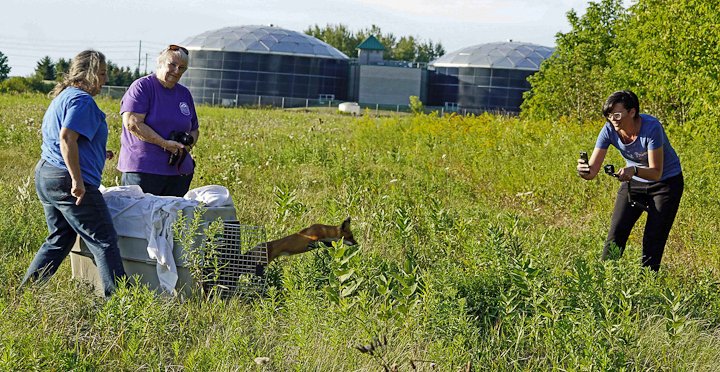
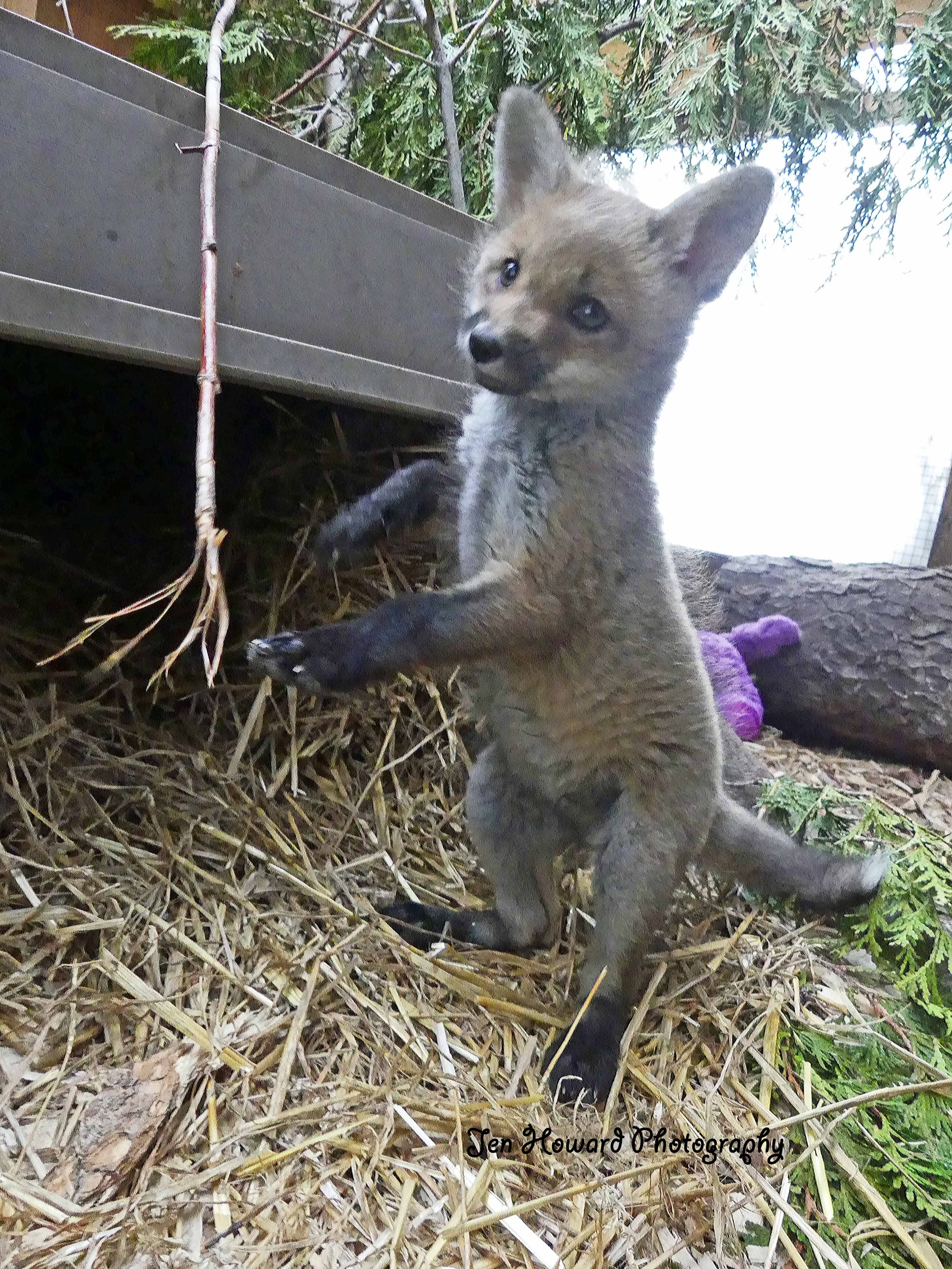
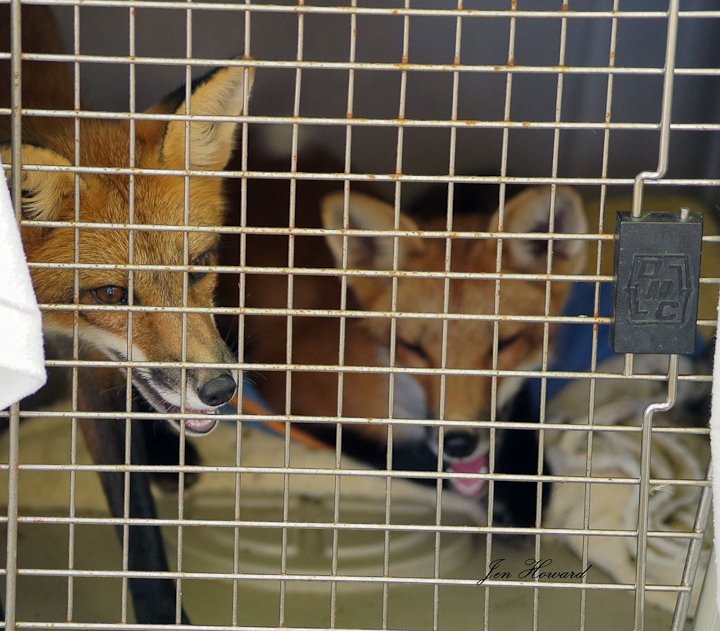
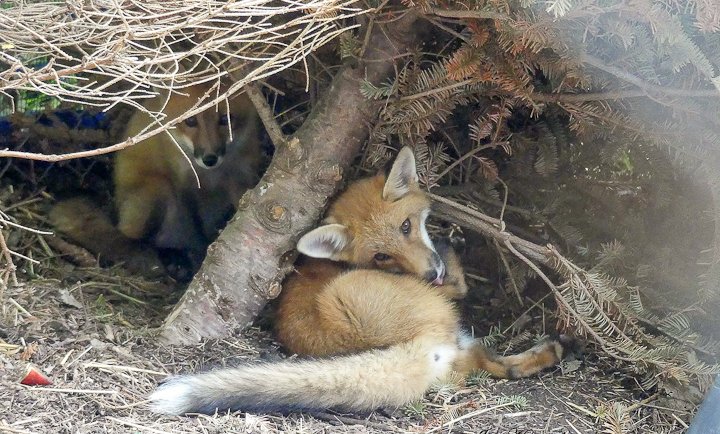
As soon as she could feed herself without assistance and was gaining weight reliably on her own, she was quickly moved into a larger outside enclosure to even further reduce her exposure to people. At that time we began searching throughout the province for another fox near her age that she could socialize with. Foxes are very social animals and it was essential to her development to be around other foxes to learn vocalizations and normal social behaviour with conspecifics.
“Caring for her was one of the highlights of my experiences as a volunteer and one that I won't ever forget. Her release together with another fox from the area was a joyful day for myself and several others.”
Work at the Centre never really ends
“After the baby stages, we are very careful to limit the handling of the animals to very few people, explains Howard, “Especially fawns, raccoons, foxes and coyotes, who are easily habituated to humans.”
Staff where gowns and masks and try not to speak in the presence of the animals. They only go out to feed and change the animal’s water at this point.
Rehabilitation Centres from other parts of the province work together to create the best environment for the animals to grow up knowing how to act and survive out in the wild.
“These species also need others of their kind, to bond with, play with, and learn from each other. That is of utmost importance so they do not get attached to their caregiver. We will search for others their age until we find one from other rehabilitation centres, then they either come to us or we go to them.”
In conclusion
The dedication and commitment shown by the volunteer staff at Procyon Wildlife Rehabilitation and Educational Centre is a testament to the type of people who have a special place in their hearts for our wild critters. This same dedication is to helping wildlife occurs everyday in rescue and wildlife refuges in the United States, Canada, the Europe, and throughout the world in countries big and small. Animals of all kinds, from the largest elephants to the tiniest creatures. As habitats are destroyed, either from natural calamities such as wildfires to the slow encroachment of urbanization, it is important for gardeners to do our part to recreate habitat in our yards for many of these creatures.
It is also falling to us to keep an eye on our backyard friends to ensure they are safe and free from illness. That includes everything from keeping our bird feeders and bird baths clean to stop the spread of disease, to taking immediate action if we see a sick or injured animal such as foxes suffering from mange in our woodland/wildlife gardens.
Take the time to look up your local wildlife refuge and make a donation. If you can donate your time or skills, I’m sure they would welcome it with open arms, if you cannot, a financial contribution to any one of these non-profit groups will go a long way to help them help our wild friends.
Ever wonder why foxes scream out in the night. Check out my story here.
The following are helpful Resources for homeowners looking for wildlife rescue and rehabilitation assistance
Worldwide
In Canada
https://www.nwrfcanada.org/what-we-do
http://www.ontariowildliferescue.ca/contact.php
https://www.ontario.ca/page/find-wildlife-rehabilitator
In the United States
• Here is an extensive state-by-state listing from the Humane Society of the United States on how to find a wildlife rehabilitator
https://www.humanesociety.org/resources/how-find-wildlife-rehabilitator
In the United Kingdom
https://www.rspca.org.uk/adviceandwelfare/wildlife/findarehabilitator
• The British Wildlife Rehabilitation Council includes a clickable download of UK rehabilitators
http://www.bwrc.org.uk/FindaRehabilitator
• Here is an extensive list of UK Animal Rescuers from Animal Rescuers.co.uk
The Fox den: How to find and identify it in the garden
Finding a fox den in the forest or in your backyard is always an exciting experience. Consider yourself lucky to be able to watch the kits grow up and the dedication the parents have as they teach them how to make their own way in the world. The den is often a series of tunnels with separate compartments for sleeping and stashing a cache of food.
How to help foxes with Mange
Finding and identifying a fox den can be either extremely difficult if it is a new, recently dug den site, or quite easy if it is a well-used den with multiple entrances and exits.
If you have a fox den in your garden and notice they are developing Mange, go to the bottom of this story for guidelines on how to help the fox fight off mange.
A well-disguised den can be as simple as a small entrance tucked under the roots of a mature tree hidden by tall grasses. The more complex dens that have been used for several years can have multiple exits and entrances (sometimes even into the teens) and a maze of deep underground tunnels that allow the foxes easy escape if a predator enters one of the den tunnels.
In our woodland gardens, however, dens are often more easily discovered in the spring after the vixen digs a den under a small building such as a garden shed or deck. The kits – usually between 1-10 in each litter – are usually born between March and May. In fact, a number of studies in the U.K. found that urban foxes were attracted to the convenience of building dens under the roof of a garden shed. A study in Bristol found 37 per cent of dens were dug under backyard garden sheds. Similar studies reported foxes found a home under a shed 15 per cent in Oxford and 25 per cent in an area of London. An Australian study found that 44 per cent of urban foxes set up their dens under some form of building.
Five tips to find and identify a Fox den
A fresh mound of dirt and a hole about a foot in diameter.
Within a few feet of the den you may find animal remains at times. there should be evidence of predation because fox will often eat their prey near the den
location of the den is often near former, well-used dens where the fox have moved on to construct a new den.
Fox will often create a den on the side of a steep bank in typically well-drained gravelly soil. The fox parents will often use the top of the bank as a lookout where they search the area for predators.
There will often be well travelled trails leading to the main denning site as well as less pronounced trails leading to secondary entrances of the denning site.
If a fox family chooses your garden for its denning site, don’t be surprised if you hear them communicating at night either through soft sounds or through very loud bone chilling “screams.”
In addition, be thankful that your urban fox family will do an outstanding job of clearing your garden of rats and mice which they prey on to keep the kits well fed.
Also, don’t be surprised if things like leather work gloves or shoes begin to go missing in your gardens. Parent foxes will often steal from the garden and bring them to the kits who use them as “toys” that begin to teach them the basics of hunting.
This den, which is actually nothing more than a teel culvert on the side of a busy road near my home, has been used for at least two years.
How long does a fox family use the den?
It’s important to remember that foxes do not treat the den like a what we would call a traditional home. Foxes, not unlike birds, build the den as a short-term location used primarily to give birth and raise their kits in relative safety.
The den is also used to store caches of food as well a safe place to go during severe weather, especially during extreme cold winter days or in stormy weather.
It is not a lifelong residence or even a location where the fox family would remain for a full year. They may visit the site on occasion, but normally only for brief periods.
The family usually leaves the den in a matter of weeks, often moving to another location, as the kits begin to explore or go out in the world to find their own way.
Foxes will often carve out a den below the roots of a dead tree.
What if a fox family takes up residence in your garden?
If a fox decides to make your garden the location to raise its family, consider it an honour. The parent foxes have decided that your property offers what they need to safely raise their family – which includes an ample source of food and water nearby and a location where they feel safe from other predators.
The Toronto Wildlife Centre (TWC), a highly respected animal rights organization in Canada, state on its website that both “foxes and coyotes are an important part of our shared, local ecosystems. By understanding their normal habits and behaviours, we can learn to coexist peacefully and even develop a deeper appreciation for our wild neighbours.”
The organization does recognize that there are times when a fox family builds a “den to raise their young underneath porches or in earth banks on urban properties. Most people count themselves quite lucky to be onlookers to such a fascinating nursery, but on rare occasions where the den is in a truly unsuitable area, fox and coyote residents can sometimes be encouraged to move their pups to an alternate den site using simple harassment methods.”
The Wildlife Centre states on its website that “playing talk radio and sprinkling human urine next to the den opening for several days is often enough to convince the family to move on.” Putting sweat-soaked socks in the area is also unappealing for fox and coyote families and has been successful in encouraging the family to choose a new site.
Are foxes a threat to humans and pets?
TWC goes on to explain that “under normal circumstances foxes and coyotes are not a threat to people.” They do warn, however, that animals “who have been habituated because they were fed are still unlikely to initiate any contact with people, but they occasionally may come too close for comfort.”
TWC is quick to point out that “limiting human food sources is the best way to prevent conflicts with foxes and to help keep them wild.”
Smaller pets including cats and dogs are traditionally not in danger around a fox, but could be attcked by coyotes if left unattended in the backyard.
Foxes have actually been known to get along with both cats and dogs to the point where they often become garden friends, playing and even napping beside one another.
It’s best, however, too never leave small pets alone outside in either urban or rural backyards. There are just too many dangers in both environments, including larger, more aggressive pets that could get into the yard and attack smaller pets.
How to help a fox with mange: Call a professional
When we first moved into our home more than 20 years ago, fox were a common sight in the neighbourhood. Shortly after moving in, however, mange went through the local fox population killing most of the resident foxes. It took them years to recover, but today a fox sighting is almost a daily experience if you keep an eye out for them at both ends of the day.
Mange continues to be a serious threat for these animals and one of the main issues animal rehabilitaters deal with every year.
Mange is caused by a burrowing mite (Sarcoptes scabiei) which infests the skin of foxes and other canids from our own pet dogs to coyotes and wolves. The resultant scratching causes significant trauma to the skin which develops thick grey, foul smelling crusts with extensive hair loss. As a result, the animals become so sick that they are unable to hunt leading to a painful death.
If you notice a fox in your garden developing a case of mange, it’s best to contact an animal rehabilitater who can provide the best care possible for the fox.
Jennifer Howard, an Ontario animal rebilitator with Procyon Wildlife Rehabilitation & Education Centre in Beeton, Ontario, emphasises that the first step is to call your local wildlife rehabilitater right away. To find a list of licensed wildlife rehabilitators in Ontario visit Ontario Wildlife Rescue. Individual States have their own organizations you can contact in the U.S. and similar groups are available in the United Kingdom.
She explains that not all vets are wildlife trained and dealing with mange requires the expertise of trained rehabilitaters.
Some fox enthusiasts suggest homeowners give a fox with mange Ivermectin in food set out for them, but Howard warns that doing that could be dangerous to both the fox and other animals.
“I know we will not give or recommend Ivermectin to anyone,” she explains. “We give it by injection at Procyon every 2 weeks with usually 2 doses doing the job or sometimes 3 doses. Ivermectin can also be given by mouth once a week. But you need the weight of the fox before administering it,” she explains.
“When we bring the fox in or any animal in the first thing we do is weigh it. That’s important to get the proper dose of meds. Ivermectin can be dangerous because there are certain breeds of dogs that can die if they ingest it, other wildlife can die if they ingest it, and without proper weight you can cause an overdose in the fox.” Howard explains.
“We had a fox come in to the centre January 6th that we weighed twice because it said she was 6.5 kg. She is a mangy fox and normally they are underweight. She sure surprised us. Some come in very tiny but don’t look it. What I’m saying here is there is no way of really estimating their weight properly. And some need more than mange meds, they may need eyes flushed and or antibiotics, wounds dressed etc. even heat lamps.”
Howard explains that “Bravecto is what we give them just before they are released into the wild as it protects them for another 12 weeks. But that too is toxic to certain other animals. You must be absolutely certain and mindful that the right animal would get it and that isn’t always doable. It’s kind of like, if your not experienced or trained under a wildlife rehab do not give meds. Our vets even say ‘no. It’s too risky.’”
Howard explains that she knows that in the U.S. things are different and even here in Canada people do administer meds on their own, but “you may actually do more harm than good if it goes wrong. And other animals, including pets, can die.”
Bravecto, she explains, can kill cats and other wild animals.
You’re not going to toss a medicated piece of meat out into the yard and run out to try grab it if the wrong wild animal or random feral cat or someone’s pet comes in to snatch it up. I know my dog is bad at grabbing things and fast, even though it is on a leash. … And that’s what we are there for, to help,” she explains.
Howard says there are “exceptions to this rule with, say a nursing vixen with mange. But, again call a wildlife rehab expert and they will help you. Always make that call. It’s so important, never ever take it into your own hands. Otherwise you may take a life instead of save one,” she warns.
Can mange be passed on to our dogs or humans
The simple answer to whether mange can be passed on to our pets and even humans is yes. Certainly our canid family members are susceptible to it, but it can be passed on to humans as well, although the mites are not able to complete their life stages on humans and usually result only in severe itchiness in humans.
How is the inside of the den constructed
If a family of foxes to decide to dig a den in your yard, you’ll likely only be aware of it because of a small entrance hole. What’s behind the hole can vary greatly.
The inside of a typical fox den can be as simple as a hollowed out room at the end of an entrance tunnel that may stretch up to seven metres or 23 feet in length. There have been reports of tunnels as long as 17 metres (56 feet). The longer tunnels with multiple exits is often the result of a den that has been expanded over several seasons and quite possibly by multiple fox couples.
Do foxes sleep in dens?
Although a family of foxes may sleep together in the den, the parents mostly sleep outside close enough to the den where they can monitor any threat that may appear, while the kits remain in the den.
In conclusion
Woodland gardeners should feel honoured to have a family of foxes living on their property. Besides being excellent for rodent control, a fox family will provide hours of entertainment in your garden, especially in early morning when you are enjoying your first cup of coffee, and later in the day when we are enjoying our first glass of wine.
In an urban setting, the fox is often the top predator in the area. Creating an environment that attracts a top predator probably means you are doing a lot of things right in your woodland garden. Embrace their presence and enjoy them in your yard while you watch over them. Keep an eye on them to ensure their safety and, if they are injured or sick, take the necessary steps to either nurse them back to health or ensure they get to professional rehabilitators that can help them.
Before you know it, the family will likely move on leaving you with only fond memories of the fox family that chose your yard to raise their young.
Consider it an honour.
Why do foxes scream?
Have you ever heard a terrifying scream at night in the garden or in a nearby woodlands? Chances are the bone-chilling sound was simply a red fox calling out for a mate. The piercing sound of a fox scream can shatter the peace of the woodland garden, but it is just one of the many vocalizations foxes make.
Terrifying screams ring out in Woodland garden
Have you have ever heard a fox screaming at night in the garden?
If you are unfamiliar with the sound, mark my word, it’s what horror movies are made of. Some describe it as a bone-chilling sound similar to a woman in distress. Others describe it as a child screaming in pain.
Despite the terrifying, high-pitched sound, it’s important to note that the scream is nothing more than a form of communication used by red foxes. The vocalization is one of a number foxes use. Rest assured they are likely not in distress, being attacked or fighting, although they could be warning another fox that they are in the area and to leave them alone.
The screams are often heard during breeding season in the spring. The scream is believed to be used by vixens (female foxes) to lure male foxes to them for mating, but males have also been known to let out screams occasionally as well.
Parent foxes with cubs may also use loud screams to warn off other foxes entering into their territory.
A beautiful young fox hunts for mice in the grass. Foxes have several vocalizations including a loud, piercing scream that can sound terrifying in the middle of the night in the woodland garden.
Foxes are territorial
Foxes can be very territorial and will aggressively defend an area from other foxes.
Their territory is very much dependent on the habitat but studies show that they have been known to hold territories as small as 0.2 square kilometres in urban areas where food is plentiful, to as high as 40 square kilometres in more natural areas. Each fox family group consists of a vixen (female) a dog (male) and their kits.
In areas where foxes are not hunted regularly, and there is plenty of food, a family group could consist of several adult offspring.
Because foxes are most active at night, you are likely to hear the screams late into the night, but as a video below shows, fox will scream during the day as well.
In my case, it was around midnight and, although the screams were clearly coming from the hedgerow in the back of the garden along a fence line, I never saw the culprit and had no idea what was causing the sound.
Check out my earlier article on the urban fox.
Fox screams are surprisingly loud
The sheer loudness of the scream made me think it was coming from a much larger animal than a fox, either a racoon or coyote.
I’ve heard a terrified rabbit, angry racoons in a battle and barking deer, but nothing is more terrifying than a single fox or, even worse, a couple of foxes running through the garden screaming at one another.
I experienced it recently while taking our dog out for her late-night bathroom break.
I was sure an animal of some kind was the victim of a predator.
There had to be at least two fox, maybe more, contributing to the raucous sound.
It wasn’t until recently that I was able to determine the exact cause of the sound. YouTube videos provided the answer. If you have know idea what a screaming fox sounds like, check out these videos.
Two fox kits sit outside their den waiting for mom to return. Foxes can be are very territorial, especially when they have kits to protect.
Here is what a fox scream sounds like
I was not fortunate enough to record the fox scream in the garden but I’ve included some links here that provides both an audio and visual (see second video) example of fox screams.
Here is a YouTube video of a couple running through a forest around 1 am. The author suggests that it may have been parents distressed after a coyote or owl made off with one of their kits. It’s possible, but it may also be that the adults were communicating either between themselves or with their kits.
Here is a fun video of a fox seemingly wanting to play with a friendly dog in the middle of the day and letting the dog know it was not impressed when it ignored the fox. The video is particularly good because you can see the interaction and see the fox actually scream.
More Ferns & Feathers article’s on foxes
Wildlife Rescue: The Year of the Fox
Wildlife Rescue: Volunteers key to Wildlife Rehab success
The Fox Den and how to find it in your garden
Why foxes steal from our gardens: Fox got my croc
The urban fox: Easy Rodent control on four legs
What other vocalizations do foxes make?
Foxes, not unlike our dogs, coyotes and wolves, use numerous vocalizations to communicate with other foxes and kits. Their vocalizations are not as varied as our family pets.
The most common vocalization from a red fox are a quick series of high-pitched, almost yippy barks. Studies have shown that the bark sequence can be used as an identification system by other foxes.
The bark and scream are quite loud so are the most often heard sounds from a fox, but their are a host of quieter vocalizations used when foxes are in close proximity.
Gekkering is a guttural chattering with occasional yelps and howls that is often used by adult foxes during aggressive encounters as well as amongst kits playing around the den.
Parents will also use a sharp bark as an alarm call to alert youngsters of potential danger.
Submissive foxes will, not unlike wolves and coyotes, often emit piercing whines that often become loud shrieks as they approach more dominant animals.
Why foxes scream: A conclusion
If you are out at night in your woodland garden or hear a load scream through an open window, chances are good it’s a fox communicating with a partner or warning another fox that it’s intruding on their territory.
Having fox in your garden is a positive sign that your property is working as a natural resource for a host of animals including predators that help to keep rodents under control.
Rejoice, in their presence and embrace the many benefits they bring to our properties. They are fascinating animals that mean no harm to our family including our pets.
There are many examples of foxes hanging out with cats and dogs and growing so accustomed to people in the garden that they will tolerate a close approach as they explore the garden.
Remember, though, that these are wild animals and not pets.
Don’t be surprised if they decide your garden is as much their garden as it is yours. And don’t be surprised, if shoes, garden gloves and other potential “toys” go missing.
Check out my earlier story about why foxes steal from our gardens.
Living with and attracting friendly little red squirrels
The American Red squirrel is a year-round resident in our woodland garden. An entertaining little tree squirrel that prefers coniferous forests, especially pine trees which are both a source of food and habitat. American red squirrels, unlike their Eurasian red squirrel are territorial and hold their own against the American grey squirrels and fox squirrels.
Red squirrels, oak trees and acorns in our woodland garden
One look at the little red squirrel and I couldn’t help falling in love.
She could not have been very old and yet was brave enough to hang out under the feeder with the big boys: Big bruising American grey squirrels (some jet black and three times larger than her), mature red squirrels, and a host of very aggressive little chipmunks.
But she held her own, keeping a safe distance from the others while she scrounged what sunflower seeds and other tidbits she could find under the bird feeders.
I’m sure mom wasn’t far away keeping an eye out for her babies. During March and April, females have litters of between three to seven babies.
If you are looking to attract the American Red Squirrel to your woodland garden, be sure to include their favourite food sources, Oaks for their prized acorns, pine trees for their seeds, native berries and flowers for their seeds (Black Eyed Susans and Purple Coneflowers are good choices). These tree squirrel also appreciate a good sized woodpile where they can hide their stash for the winter.
Technically, this little red squirrel was actually what we call an American Red Squirrel, not to be mistaken by the even cuter and much more timid Eurasian Red Squirrel.
A digital digital painting of one of our cute little red squirrels.
The British counterpart (Eurasian Red Squirrel), complete with its adorable tufted ears, is actually becoming a threatened species in most parts of Europe because of its more timid, non-territorial stand against the introduced American Grey squirrel, which are all too familiar in backyards across the United States and Canada. The Grey squirrels were introduced to Great Britain in the 1800s resulting in the slow decline of the red squirrels. It is estimated that at one time red squirrels numbered in the 3 million. That number is now at about 120,000.
Dani Conner’s baby red squirrels video
For more on the Eurasion Red squirrel, be sure to check out Dani Connor and her entertaining You Tube channel about the Eurasian Red Squirrel. Dani is a talented wildlife photographer and Zoologist originally from London, UK who is now living in Sweden.
Recently she became mom to four orphaned baby red squirrels and has spent a lot of time with them gaining their trust. The kits allowed her to photograph them and record the sound they make when they eat, which went viral on Twitter gaining 14.8 million views.
Her YouTube videos are well worth watching and she has a Patreon site you may want to investigate.
American Red Squirrel at reflection pond.
If you are lucky enough to have American red squirrels in your backyard, you’ll know why the grey squirrels won’t be forcing them out any time soon. When it comes to who gets fed first around our feeders, the red squirrels make it clear up front that they’re not about to back down to the much larger greys.
Besides their willingness to communicate (the American red squirrel can often be heard communicating with a lengthy, descending trill and a persistent chatter of assorted notes and chucks), they are not afraid to show their annoyance with competitors around a food source.
In our yard their vocalizations are also one of the early warning signs that an intruder is about – especially one of the neighbourhood foxes. The Red Squirrels carry on for quite some time warning others of the dangers – including a hawk or own if they see it first.
I’ve seen one red squirrel chase a much larger grey squirrel from one end of the yard to the other when the grey squirrel intruded on its dinner party. I think it’s as much a game as it is a show of strength because they all more or less get along under the feeder. The real aggression is more likely between two reds than a red and a grey.
It can be great fun watching these little guys from inside the photographic blind. I’m sure they know I’m there, but they eventually become oblivious to me and the blind. In fact, I’ve had them jump on the blind while I’m inside mistaking the camouflage for a real tree or bush.
An immature American Red Squirrel looking for scraps of food under the bird feeder, always on the watch for predators and other feisty fellow. How can you not fall in love with this little fella?
On another occasion one Red squirrel chased another right through the blind when I was sitting in it. In one side and out the other before I even knew I had a couple of visitors.
Red squirrels can be feisty and territorial toward intruders, especially when food is involved. A showdown between two red squirrels is sure to involve plenty of tail flicking, chattering and even foot stomping. Trust me, it may look like they are having fun, but the argument can get pretty heated at times.
That tail of theirs can measure about half the size of the squirrel and when they are not using it to assert their dominance, its primarily used for balance as the squirrel moves from tree to tree in the woodland garden.
A lovely little Red Squirrel poses on a branch as it enjoys a snack.
Are red squirrels friendly?
I’ll never forget the time I was feeding one of our red squirrels peanuts and photographing her in our front garden, when she got around behind me and jumped up on my shoulder. Now that was an experience I’ll not forget.
She didn’t stay long and after a quick sniff she jumped down onto a rock to continue scoring peanuts from me.
Although they are territorial around other red squirrels, these little fellas are quite friendly and can be trained to take peanuts right out of your hand.
Unlike our chipmunks, I tend to just toss them their treats rather than have them take the peanuts directly from my hand. (See my article on how to hand feed chipmunks.)
Are American Red Squirrels a threatened species
The American Red squirrels’ aggressive/territorial approach to guarding food helps keep our red squirrel numbers healthy and might account for our baby red squirrel holding her own in the face of a host of other, much larger squirrels around her.
Although red squirrels can be rare in some areas, including urban areas, their numbers are not under threat in North America. Unlike the Eurasian reds, whose numbers have fallen dramatically and efforts are having to be made to protect the remaining populations.
You may also have Fox squirrels living or visiting your bird feeders. It is typically found in the eastern United States and Canada. Not unlike the smaller American Red Squirrel, the Fox squirrels have a lot of red in their coats, but they are actually much larger. In fact, they are the largest tree squirrel in North America weighing up to two pounds compared to the much smaller Red Squirrels that weigh in at an average half pound.
American Red Squirrels do not hibernate. Instead they store large caches of food in what is called a midden.
According to the extremely informative website Squirrels At the Feeder, the main difference between the American and Eurasia Red Squirrels can be seen in how they store food for the winter. Both of these species stash away food for winter months as neither species hibernates. The Eurasian Red Squirrel scatters the food caches in multiple locations throughout the forest. The American Red Squirrel creates a massive central stash called a midden which it defends with its life.”
What do the American Red Squirrels eat
Since our red squirrels don’t hibernate during the winter, they are extremely busy in the fall collecting food for the upcoming cold months.
Red squirrels, by definition are omnivores, and their diet may surprise readers. Their primary diet consists mainly of the seeds and cones of evergreen trees as well as nuts and, especially acorns. Their diets, however, actually extend to include native flowers, a variety of berries, mushrooms, bugs, eggs, small birds and even mice. Yes, red squirrels can help you control the mice population around your home.
Where do Red squirrels store their food?
Our red squirrels use tree cavities, brush piles and dens as their own food pantries where they can keep them safe from other foragers. (For my earlier article on building a brush pile go here.)
Around my home, they are regular visitors to the area under the bird feeders where they gather sunflower seeds and other droppings from the feeders. Unsalted peanuts (either shelled or unshelled) are a favourite treat that I like to offer them.
Where do they live?
The American Red Squirrel prefers coniferous forests and are particularly fond of pine forests but they will also inhabit deciduous woodland and are found in woodlands in suburban and near-urban areas throughout their range.
Their range is considered wide, stretching throughout the United States from the Alaskan forests through the Rocky Mountains in Canada to about Georgia.
Can Red Squirrels be problematic?
Like any rodent, red squirrels can become an annoyance if they get into the attic or other area where they do not belong. Their winter caches of food are a dead giveaway that they have moved in.
It’s always wise to use wildlife-friendly professionals to safely remove any rodents that find their way into your home.
Be sure to seal off any areas around the home to ensure there are no areas of easy access to your attic and you can enjoy these friendly little squirrels in the natural areas of your yard where they belong.
Do NOT cut down that dead or dying tree
If you are lucky enough to have a dead or dying tree in your yard, do everything you can to protect it. The birds, animals, insects and fungus will thank you for it. Beautiful trees might be wonderful in our gardens, but dead and dying trees are more important to many birds and animal life.
Create your own “wildlife tree” in the backyard
A tree growing beautifully in your woodland is wonderful, but to birds, bugs and other backyard critters a dead or dying tree is even better.
If you have a dead or dying tree in your yard (often referred to as a “snag”) consider doing everything possible NOT to cut it down. These trees are just too important to the local wildlife to cut down for no reason than it has succumbed to the ravages of time or disease. The dead tree will quickly become a magnet for important birds, insects, and microbial fungi that might not already be present in your woodland garden.
Woodpeckers, warblers and other insect eating birds will find the dead tree irresistible and over time use it as a resource for food and possibly a home to raise their young. Depending on where you live, small mammals like raccoons, skunks, martens and even porcupines might decide to take up residence in your “wildlife tree.”
This Pileated Woodpecker was photographed working on a dying tree in a back corner of the yard.
The snags can even become more important in winter where birds that depend on insects for survival look to the snag as a source for insect, larvae and other potential food sources. During winter, birds, bats and other small animals will often roost behind the loose bark and large cracks in the wood for both warmth and shelter.
Studies show that in areas of the United States West of the Cascade Mts, 39 species of birds and 14 species of mammals depend on tree cavities for survival. Similar numbers (39 bird species and 23 mammal species) East of the Cascade Mountains depend on snags. (USDA Forest Service)
The wildlife tree is the perfect “snag” with vines beginning to climb up the trunk and natural nesting cavities.
Of course, if the dead or dying tree poses a significant danger to either individuals or your home, steps should be taken to ensure the situation is made safe. This does not, however, automatically mean that the tree needs to be cut down.
There are options to save many of these trees that we will discuss later in this article.
Unfortunately, most snag or “wildlife trees” are too quickly cut down by homeowners, city parks and even within urban forested areas for fear of injury.
These trees are too often cut down without much thought, if any, to their wildlife value or of the potential options that could save all or most of the trees to live on as an important wildlife tree.
Many of our backyard animals depend on snags for both nesting and living accommodations as well as foraging for food.
Why preserve a dead or dying tree?
The dead trees, especially larger ones, provide optimal habitat for woodpeckers and other primary cavity nesters. In fact, large snags from mature trees are critical for big birds such as Pileated woodpeckers that require more available internal space for raising their young.
Woodpeckers such as the Pileated or Northern flicker actually create several new cavities in dead and dying trees per year. Many of the cavities are started by the woodpeckers for possible use in future years, but in the meantime, are often used by smaller bird species.
The woodpeckers will often start the cavities in areas of the tree that is weakened and then leave to allow nature to finish a lot of the hard work.
Fungus eventually invades the cavity and softens the wood over time. The following year, the birds may return to continue hollowing out the cavity’s internal wood, which has now become softer and easier to excavate.
Wildlife tree
Can’t you just imagine a large eagle sitting atop this old snag scouting the area for its next dinner? It’s more likely home to an owl along with a host of smaller birds, bugs and other critters.
Woodpeckers, in turn, create habitat for more than 80 other species of secondary cavity nesters, including American kestrels, a host of owls from the diminutive Screech owl to Barn owls, Barred owls and even Great Horned owls, swallows including the tree swallow and purple martins, bluebirds and a host of wrens, chickadees and nuthatches.
Owl box on pine snag
A screech owl box on this dying fully mature pine tree provides and opportunity to attract the diminutive little predator even if you do not have a large enough dead tree in your yard.
What do all these birds have in common?
They are primarily carnivorous or insect-eating birds that will help to naturally control mice, rats and insects in your garden. Without them, your garden can easily get out of ecological balance. In fact, many urban gardens, where dead or dying trees no longer exist, are overrun with mice and rats and skunks in part because of a lack of nesting cavities in the area for higher predators. Great Horned Owls, for example prey on skunks.
If your area has few if any natural snags, it may be the perfect time to look into installing screech owl boxes that provide nesting opportunities for these small, but highly efficient mice and rat controllers. If attracting screech owls sounds interesting, check out my full article on installing screech owl boxes in your garden, go here.
Even small snags are vital to wildlife
This American Bittern was attracted to this fallen snag in a pond. A dead or dying tree, whether it is standing or fallen over, can attract an amazing variety of birds, animals and insects.
Smaller snags, particularly if the wood is beginning to break down and becoming soft, provide the opportunity for smaller birds such as chickadees to make tiny cavities in dead wood as small as 4-inches in diameter.
So, even if a smaller tree dies in a corner of your garden think twice before removing it. This is the perfect opportunity to grow a vine up the snag or plant a native berry producing shrub in front of it not only to hide it from view but to provide an abundance of natural food to inhabitants of the snag.
Snags as nesting sites and foraging habitat
This small DIY snag is the result of burying a branch into the ground and allowing the woodpeckers, nuthatches and chickadees to go to town on it. Eventually it will rot and I’ll replace it with another.
Although many gardeners will recognize the benefit of the snag providing nesting habitat for a variety of birds and mammals, don’t overlook the foraging opportunities these same snags provide.
The dead and dying trees’ wood softens as fungus begins to take over the once dense woody interior of the tree. This soft wood, which can also exist on dead branches on live trees, provides habitat for a host of insects and other potential prey items for birds.
You might be surprised just how many invertebrates depend on dead and dying trees.
A close inspection would likely include a host of beetles, spiders, various ants, millipedes, earwigs, earthworms as well as possibly salamanders and toads on the ground beneath the tree living under the decaying bark and branches that often fall from the tree.
This snag continues to show life in another part of the tree, providing needed cover for birds and animals that are using it for habitat.
Some of the best trees for snags
• Large trees provide the most habitat resources for birds both small and large
• Conifers such as cedar, fir larch, and pine make excellent snags because they rot slowly and can remain standing longer.
• Snags of more than 12 inches in diameter and about 15 feet tall are perfect hunting perches for larger raptors.
Brush Piles
A red squirrel enjoys the bounty provided by the woodpile that can help to take the place of a snag. If you are limbing a dead tree, consider using the branches to create a wood pile. Eventually the rotting branches will create a similar benefit to wildlife that the standing dead snag would provide.
Create your own DIY snags
If your property has no dead or dying trees, you could create your own either by killing an undesirable tree in your yard, or better still by burying a large branch in an appropriate area of your yard.
Maybe a neighbour is cutting down a large tree and the tree service has no problem dropping off a large branch to your home. By simply digging a hole and burying it in the ground, you could create many of the benefits a traditional snag would bring to the yard.
I doubt you would get a pileated woodpecker making it’s home there, but you will attract woodpeckers, nuthatches, chickadees and other insect-eating birds to the yard.
If the branch is big enough, you may be able to get nuthatches or other small birds using it to raise their young.
You might want to drill some large holes in the branch to get the process started.
Snags in our yard
In our bckyard, we have a large natural snag in a corner of the yard that most visitors would be hard pressed to see unless they walked back to the more wilder area of the yard. Judging by the holes bored into it, I’m sure it is and has been home to several smaller birds.
Last year, a Pileated woodpecker was working the snag foraging for insects. I heard it before I saw it. In fact, I had to walk to the back of the yard to see the massive woodpecker at the snag.
In another area of the garden near the bird feeder, I have buried a mid-sized branch in the ground for birds to use both as a perch as well as a snag.
By drilling holes in the branch and filling them with suet and WBU bark butter, the DIY snag is regularly visited by a host of woodpeckers, nuthatches and chickadees as well as the perfect high perch for red squirrels watching for the neighbourhood fox.
If you want to take DIY snag creation to a higher level, consider wrapping a rope tightly around a large branch to cut off its nutrients from the main trunk. In time the branch will die off creating a form of snag on the tree. (I would not recommend this procedure on your favourite tree).
Smaller DIY snags can be easily made from large branches that can be drilled out, filled with suet or Bark Butter, and hung from a nearby tree. For my story on building your own hanging DIY suet feeder, check out my story here.
We have created a large DIY snag branch on a very mature crab apple tree at the back of the property. For the most part, the dead branch is hidden by the still living branches, but still provides many of the benefits attracting insects that are eventually food for the backyard birds.
In our yard, we have also created a large wood pile that can take the place of a snag by providing small animals with a relatively safe habitat as well as a good foraging location for birds. For more on building a brush or wood pile, check out my full story here.
By wrapping a rope around a branch of one of our crab apple trees we are able to create a snag in a living tree. By doing this, you can create a snag where ever you choose.
Managing snags in your landscape
There is no question that a large dead or dying tree can pose a risk to life and property if not dealt with properly.
If a snag threatens the safety of a patio or play area for example, consider moving them to a safer area if possible. If that is not possible, reducing the potential damage that could be caused by the snag falling over is certainly a consideration. By removing the larger branches and using them in a woodpile for example, you keep the benefits of the dead wood without the dangers.
If the snag is a large, mature tree and poses too much danger to leave it as it is, have a tree company remove the dangerous branches and cut the tree down in size so that if it did fall, it would not hit anything and, its reduced size would pose little danger.
How long can a dead tree remain standing?
It’s also important to remember that a dead tree can stand for many years before it topples to the earth. In fact, depending on the size and type of tree, it’s likely that the dead tree will still be standing long after we are gone.
Finally, if you are concerned about a tree on your property that might be dying or has already passed, contact a local tree specialist for their expertise.
Just remember that a lot of these “tree experts” are not only in the business of making their livelihood from removing trees, they also do not want to be responsible for any chance of injuries or property damage resulting from a falling tree that they did not remove.
Common sense is always the best approach, but keep in mind there are alternatives to complete removal and they are almost always a lot less expensive.
While I get great enjoyment from my bird feeding stations, providing natural food sources to our feathered friends is always the goal we should aspire to in our gardens. I have written a comprehensive post on feeding birds naturally. You can read about it here.
Why do foxes steal from our garden? Fox got my Croc
Somewhere in my neighbourhood is a lost and lonely Croc. It disappeared during an overnight crime spree carried out with great stealth. Our dog saved one by her barking. I am worried about the other.
Closing in on the crime
Somewhere in my neighbourhood a lost Croc is scared, lonely and likely getting chewed on.
I rescued its sibling on a patch of parched earth in the middle of our lawn.
The saga began when I woke up, looked out back to ensure it was safe to put Holly out for the morning. Just two days earlier, she got skunked and I wasn’t going to let that happen again.
(You might want to check out my other articles on foxes: Why Foxes Scream and The urban fox and how it controls rodents like mice and rats.
In the middle of the lawn, what looked like a dead squirrel lay motionless.
Earlier, Holly had been barking at the window. I imagined the barking scared the fox who dropped the squirrel. I went outside to move the dead animal.
Young foxes like to use “toys” such as shoes and gloves to learn life skills including catching prey.
When I stepped out the back door I noticed my old Crocs were nowhere in site. I remember leaving them just outside the door after watering the garden the night before.
Barefoot, I walked out to the middle of the grass. There it sat, motionless. My old Croc, all alone in the parched grass. No doubt, left there in haste by our friendly neighbourhood fox on its regular morning visit.
This wouldn’t be the first time a fox decided to take something that was not theirs. Foxes have been known to make a habit out of stealing people’s shoes. In fact, some have even become famous for their shoe fetishes.
Take the shoe-loving foxes from a neighbourhood in Japan that pilfered 40 pairs of sandals before being nabbed in the act of the crime after a six-hour police stakeout.
This fox is hunting for mice in a grassy area of the garden.
The pair of sly foxes were discovered after police received reports of footwear mysteriously disappearing from eight households in Nagaokakyo, about 235 miles (380km) west of Tokyo.
Five police officers were involved in the stakeout that ended with the discovery of two foxes who had made their home in the garden of an empty house, with 40 pairs of shoes scattered around a burrow.
In a German town, a fox was responsible for stealing more than 100 shoes.
In England, 50 shoes were found along a path near a fox den – runners and work boots seemed to be the favourites.
So I am not alone. My Croc joins a long list of missing shoes stolen from yards while their owners slept soundly in their beds, totally unaware of the crimes happening all around them.
What makes them want to take our shoes?
From a website on foxes: “A wide range of objects can be found close by a breeding den – besides pieces of paper, plastic and bone there is an array of leathergoods like chewed shoes, gardening gloves or balls. Fox cubs have used them to play with. These “toys” are apparently presented to the young cubs by adult foxes. Later, older cubs bring them back from their own adventure tours.”
The same site describes how fox cubs use the “toys” to play with their siblings and use various “objects to train their hunting skills such as how to catch and handle their prey.”
So, some advice to my fellow gardeners: Don’t leave shoes, including your favourite Crocs or gardening gloves (especially leather ones) outside overnight. Consider putting away any other articles that you think might be a score for the neighbourhood fox.
We don’t need any more orphaned Crocs.
Be sure to check out my other articles on foxes: Why Foxes Scream and The urban fox and how it controls rodents like mice and rats.
Tips and ideas on how to de-skunk your dog
It all happened so fast. And it can happen to you and your dog if you are not careful. Here are some tips to deal with a skunking and ideas to help stop if from happening again.
Taking the stink out after getting skunked
It all happened so fast.
Holly and I go out every night at around 11 for her final pee. She loves it because she knows there’s a treat at the end. Maybe even two. Well, usually at least two.
It’s a quick in and out, no problem.
Not knowing what awaits us as we step outside, Holly is always on a leash and usually just a few steps in front of me until I’m sure the coast is cleared. The main back light is turned on to supplement the many solar lights and anything that is out there is given ample warning that we are coming out.
I guess no one told Pepe Le Pew the routine. The skunk was hiding behind a large rock on the edge of the patio probably busy digging for grubs. He was just steps from the back door. I think Holly was as surprised to see him as he was to see Holly. All I saw was Holly standing over the little guy before a flash of a black and white tail prompted me to yank the leash back and get her inside.
Then it hit me.
A skunk looking for food in the early evening.
Skunk spray is a form of sulfur. that is released in an oily form. The oil can stick to many surfaces and permeates everything it touches. Once released, the skunk smell fills the air and seeps into everything. It’s a good idea to close all exterior doors and open windows to keep the smell outdoors. The smell can even permeate skin and it’s not unusual to have the odour in your mouth and nose for a period of time. Is it any wonder that, if not treated properly, a dog can carry the smell for up to two years? Especially when its fur gets wet. Just ask a dog groomer. Most will not even take a dog that has been sprayed recently for fear of contaminating their grooming facility.
Holly’s smell was ripe and spreading through our small back landing. I called out for help. Paper towels please and plenty of them.
Be aware that skunks are particularly active in mid Feb. when you might not expect to come across them. This is their mating time and they are often seen during the evening but also during daylight hours roaming around even when there is significant snow on the ground. For more on their Valentine adventures, check out my post here.
Probably not a good idea to bring her inside immediately after getting skunked but I wanted to check her eyes. It’s important to check their eyes; if they're irritated or red, immediately flush them with cool water.
Her eyes seemed fine.
You know that skunk smell you get when you pass one that has been hit on the road, It was nothing like that…
Pungent. Not nice at all.
It wasn’t Holly’s first encounter with a skunk and it surely won’t be her last. After wiping her down as best as I could, we put her and her friend Monet (the cat) in the basement for the night. I felt sorry for both of them, but that’s all we could do at that time.
I would deal with her in the morning.
At first light I was up to take the little stinker outside. I expected the worst when I opened the door to the basement. I was greeted by the cat and dog together at the foot of the stairs. Not sure if Monet felt sorry for Holly or the smell wasn’t bad enough to keep these two buddies apart.
Turns out Holly was able to dodge a bullet. Either she sidestepped the worst the skunk had to offer or the skunk was still a baby and didn’t pack enough punch to make it stick.
Either way, the back entrance seemed to get the worst of it all. A complete cleaning with a Lysol cleaner and then swiffer wet, some scented candles and a diffuser running Refresh from Sage, and it’s liveable again.
Commercial de-skunking products such as Natures Miracle Skunk Odor Remover should probably be your first step to deal with the problem quickly.
Other highly rated products include: Van Den Heuvel’s R86 Industrial Odor Eliminator which is non-toxic and biodegradable. Not only does it eliminate just skunk odors, its combination of more than 30 different essential oils and natural ingredients, can eliminate several odours and is safe to use around children; Bodhi Dog Pet Deskunk Spray Odor Eliminator advertised as containing a combination of essential oils and useful on flat areas both in the home and outdoors; Skunk-off Liquid Soaker, a fast acting solution also useful on hard surfaces around the home; De-Skunk Odor Destroying Shampoo.
But being ill-prepared, I had to make a quick trip to the pet store for some de-skunking shampoo. After a good bath in her bottle cap pool, she’s almost as good as new.
This skunk was wandering through the garden one evening showing off its beautiful tail.
Lessons learned from dog getting skunked
First lesson: Be extremely careful when taking your dog out at night. A combination of solar lights and the back light is good, but it’s not enough in a garden where skunks can be hiding behind plants, rocks or containers. Skunks don’t run fast, so give them time to clear the area. Maybe include a powerful flashlight at the back door for a pre-surveillance before going outdoors with the dog.
Second lesson: Be prepared. There’s not much you can do at 11 pm to deal with the situation if your cupboards are bare of the essentials to de-skunk your dog, or yourself, for that matter. Get some supplies (commercial de-skunkers, old towels, distilled water, rubber gloves, a face mask), put them in a box and have them ready for the big night so the skunking repercussions can, at least, be minimized.
Third lesson: Keep the area around the back door relatively open to lessen the chance of surprising the stinky ones. Always take your dog out on a leash. Despite the leash, she still got skunked. I can’t imagine letting her out on her own. Maybe yanking her back when I saw what was happening was enough to keep the damage to a minimum.
There are several commercial de-skunking remedies available that are simple to use and provide some immediate relief from the odour.
A common DIY concoction comes highly recommended by the humane society
Mix together:
1 quart of 3-per cent hydrogen peroxide (available at most pharmacies)
1/4 cup baking soda
1 teaspoon liquid dishwashing soap preferably Dawn ( highly recommended by wildlife rescues.)
The hydrogen peroxide strips the skunk’s oil from your pet’s coat, and the baking soda helps to neutralizes the smell. Keep the formula away from your pet’s eyes, mouth, ears and nose and do not let your dog swallow any (it will cause immediately vomiting.)
Pop on some rubber gloves and wash your dog with this solution as soon as possible after they’ve been sprayed.
This DIY mixture CANNOT be stored for later use. The components in this mixture could explode if left in the bottle.
Clean and Rinse: Rub the mixture through the dog’s fur, but don’t leave it on too long (peroxide can bleach fur). Rinse thoroughly.
Shampoo: Next, wash your dog with pet shampoo preferably a de-skunk shampoo and rinse thoroughly. Towel-dry the dog and leave it in a warm dry area. Now is not the time to leave it out in the cold or in a cold garage unless there is a bed and a heater nearby. By now, the smell will be either completely gone or, at best, just slightly stinky.
Wash towels and human clothing separately in a normal wash cycle.
This page contains affiliate links. If you purchase a product through one of them, I will receive a commission (at no additional cost to you) I try to only endorse products I have either used, have complete confidence in, or have experience with the manufacturer. Thank you for your support. This blog would not be possible without your continued support.





